PinotFile: 8.35 April 11, 2011
|
Balance in Wine: A Personal AestheticBalance is an abstract term that is offered as a high accolade whenever quality of wine is analyzed. It represents a subjective harmony between all of wine’s components that produce flavors and haptic characteristics (sensations appreciated by the palate) of taste, including acid, sugar, alcohol, tannin, fruit extract, oak, and texture, with no one element dominant. With over 300 chemical constituents in wine, it is impossible to analytically arrive at a determination of balance. We are left with our personal taste to ascertain balance and therefore quality in a wine. Balance is a personal aesthetic that is hard to describe, almost like explaining sex to a virgin, but we know it when we experience it. Definitions of balance abound and here are a few examples: Karen McNeil, The Wine Bible: “A wine that incorporates all of its main components - tannins, acid and alcohol - in a manner where no single component stands out.” eRobertParker: “One of the most desired traits in a wine is good balance, where the concentration of fruit, level of tannins, and acid are in total harmony.” Emile Peynaud, The Taste of Wine: “A wine is said to be harmonious when its elements form a pleasing and well proportioned whole. In a good wine, everything should be harmonious; quality is always linked to a subtle play of balances between tastes and smells.” Winemaker Jim Clendenen of Au Bon Climat (at this year’s WOPN): “Balance is a person that wakes up in the morning and does the New York Times crossword puzzle. They are motivated, educated and want a challenge. That’s balance. Then there’s the intellectually lazy, uneducated unmotivated person who does the USA Today crossword puzzle.” Jeffrey Patterson, proprietor and winemaker at Mount Eden: “A balanced wine is one in which the last glass tastes better than the first.” Ted Elliott, winemaker, T.R. Elliott : “If a wine tastes great, yet you can’t describe it, it’s in balance.” Some facts about balance which help to further define it:
A number of descriptive terms are employed to describe wines that are not in balance. Hard or harsh or astringent: too much astringent tannins. Fat or lush: rich and concentrated, blessed with extract; if too fat, said to be flabby. Thin: lacking fruit. Austere: acidity levels are high compared to fruit and in its worse form said to be tart. Terms can also be complimentary descriptions of balance. Supple refers to a harmonious, soft and velvety wine. Crisp or lively describes a pleasing sense of acidity. Balance in wine is temperature dependent. Tannins are more noticeable and a wine seems more acidic when the wine is at a low temperature. Alcohol is more apparent at high temperature. Balance is in the eye of the beholder. We know that individuals differ in their sensitivity to alcohol and tannins. The taste genes determine how many taste bud receptors a person has for sweetness, sourness, saltiness and bitterness. Hyper-tasters do not enjoy strong tannins and high alcohol. Regular tasters (at 75%, the majority of the population) find sugar more palatable, high alcohol less bitter, and tannins less repulsive. Non-tasters are more forgiving of strong tannins and alcohol. Balance in wine is a delicate interplay. An increase of one element can obscure the perception of another element, For example, tannins are more pleasing if acidity is low and alcohol is high. Acidity is perceived as well integrated when the alcohol percentage is higher. Balance is an indicator of age ability. Acidity and balance are the key factors that determine the aging capability of a wine. Balance is often tied to alcohol in the public’s perception. Many believe a wine with high alcohol, say above 15%, cannot be balanced. Allen Meadows, aka Burghound, has said, “I flatly disagree that a 15% alcohol wine can be balanced.” Others would disagree, and this has become a contentious issue. Low alcohol is no guarantee of balance, and wines with an alcohol percentage of, say, 13.5%, can be unbalanced. Can an unbalanced wine assume balance over time in the bottle? I have heard the comment bantered about by a number of knowledgeable wine people, “If a wine is not balanced when it is put in the bottle, it will never be.” There is disagreement over this and the remarks of winemakers to follow provide insight on this issue. Balance and style in wine are intertwined and the style of the wine will often dictate the possibility of balance. The goal of Pinot Noir winemakers today is to achieve balance in wine naturally, without alcohol reduction strategies or acid modifications. This topic has been the subject of seminars at the recent World of Pinot Noir (“Alcohol and Balance”) and in San Francisco (“California Pinot Noir: In Pursuit of Balance”). At the San Francisco event, attended by members of the trade and press, the moderator, Ray Isle, offered the question, “Does Pinot Noir require more balance than other varieties?” A corollary of this is the question, “Is it more difficult to achieve balance in a Pinot Noir wine?” These are interesting questions and the answer to both is probably “yes,” but the winemakers and sommeliers in attendance never really answered the question. One thread that ran through both seminars was the critical relationship between wine balance and vine balance. There is general and emphatic agreement that Pinot Noir vine balance results in better fruit quality, and increases the potential harmony of the finished wine. Dr. Andy Reynolds, a viticulturist at Brock University in Ontario, Canada, remarked (American J Enol Vitic, 56:4, 2005), “There is a general acceptance that high quality wines are produced from vineyards where balance is maintained between yield and vegetative growth.” This is a critical idea that I will briefly explore. Vine balance can be achieved through viticulture practices and can be measured by both qualitative and quantitative criteria. Qualitative criteria are defined by the appearance of the vine, including its vigor and leaf color. Patty Skinkis, of Oregon State University (www.extension.org/pages/33109/basic-concept-of-vinebalance) provides a summary of how vine balance can be quantified. “Vine balance is the state at which vegetative and reproductive growth lead to the most ‘balanced’ vine. Vine balance is measured by vine growth and capacity through fruit yields and vine size and can be defined and characterized as the ratio between vine yield and vine size (representing reproductive and vegetative production of the vine, respectively). This relationship is known as crop load and is calculated by taking the vine’s yield and dividing by the dormant pruning weight. A vine is considered in balance within the range of 5-10:1 for vinifera. A low ratio (low yield, large vine) means the vine is under cropped and a high ratio (more fruit, smaller vine) signifies the vine is over cropped.” Other quantitative measures used to understand vine balance include cane pruning weight alone (a weight of 20-30g/cane is considered balanced), vine leaf area, cane diameter, and inter nodal length. Achieving ideal vine balance is challenging and influenced by many factors including climate, soil, rootstock and scion, canopy management, trellising, water availability, disease and pests. It may take a grower generations to fully understand the complex interplay of these many factors, a realization voiced by experienced grower, David Hirsch, of Hirsch Vineyards in the Sonoma Coast at the recent San Francisco seminar on balance. With this information as background, who better to ask about wine balance than winemakers? I approached several noted Pinot Noir winemakers and asked them three questions: (1) What is your definition of wine balance? (2) How do you determined balance in a wine? (3) Can wine be naturally balanced, and if it is not, what role can vinification play in achieving wine balance? I also posed three questions to some of my readers: (1) How do they define balance? (2) How do they determine if a wine is balanced? (3) Is balance important in their choice of Pinot Noir to drink? Michael Cox, Winemaker, Schug Winery, Carneros, California. (1) “My definition of balance is tied to acidity/fruit/tannic structure. For me, these are the three key components of a wine. If the balance is tipped too much in one or more directions, the wine is less than it could be. Overtly fruity wines are nice, at first, but without acidity and tannins to act as counterweights, they just simply fall a bit short.” (2) “The only way to determine if a wine is balanced is to taste. We all have our own ‘sweet spot’ of balance and that varies with wine type to a degree. In blend decisions at Schug, we tend to focus on the balance aspect. My own view is that if the wines tastes right, the aromas will follow.” (3) “Wine should be naturally balanced, though sometimes a winemaker can lose sight of that during harvest in pursuit of an artificial number. That is where skill and craftsmanship in winemaking comes through. Knowing your vineyard and when that fruit is ready, allows you to make a balanced wine. That requires tasting in the vineyard and hard-earned experience. That doesn’t mean that winemakers should not intervene if a wine seems out of balance. There are decisions (acidification, fermentation regimes, oak programs, aging regimes, etc.) that can be made to bring a wine back into balance.” Eva Dehlinger, Winemaker, Dehlinger Winery, Russian River Valley, California. (1) “It is useful to think about balance as an overarching principle rather than as a strict definition. A balanced wine is simply one that has harmony between various structural elements. For example, a wine where the most important factors complement each other well. An unbalanced wine may have one or more components that are noticeably unwieldy considering the profile of the wine. For example, this could be too much or too little acid, alcohol, tannins, sugar or oak. Such imbalance is distracting and detracts from one’s overall satisfaction of a wine. Happily, there are many profiles of balanced wines, and this affords us diversity in vinous enjoyment. A balanced dessert wine will have far more acid and sugar than a balanced Cabernet Sauvignon, which in turn will have a far more tannic structure than a balanced Pinot Noir. Even within a given varietal, there is no one Platonic ideal-like balance point. Balance is also a matter of circumstance. A wine that has excessively prominent tannins or acid when tasted alone might actually be a perfect compliment to a robust or rich meal. Furthermore, balance is not an immutable property of a wine. Wines can come into balance. For example, tannic wines can soften with time.” (2) “While there are guidelines for determining if a wine is balanced, there will never be a set formula. With this in mind, the only real way to determine balance in a wine is to taste it. Once engaged with a wine, factors that I find particularly germane are structural: tannins, acid and weight. Paramount is how these compare to one another. I ask, is one feature clearly distracting or unsatisfying? The ultimate test: If I continue to want to refill my glass with a particular wine over the course of a meal, it is probably in good balance.” (3) “What constitutes a perfectly balanced wine is subject to personal preference, regional and cultural norms, fashion, and circumstance. Therefore, it is not clear what a ‘naturally’ balanced wine would refer to. For example, harvest maturity, oak treatment, and blending choices are all conscious decisions a winemaker makes with the intention of achieving a particular balance point. In our own winemaking at Dehlinger, we spend a significant amount of energy fine-tuning balance through the blending of our many lots of Pinot Noir. Primary concerns include clarity of fruit, desired textural profile and acidity. Combining various lots can accentuate or play down a feature that may be more or less prominent in a particular individual lot. Determining the balance of the final wine requires numerous permutations of trial blends tasted on various occasions, both with and without food.” Laura Volkman, Winemaker, Laura Volkman Wines, Chehalem Mountains, Willamette Valley. (1) “In my experience, balance involves four components: alcohol, fruit, acid and tannin. As a winemaker, we look to preserve the fruit components and use the other three to complement the fruit. In Pinot Noir, for example, we are trying to show off the delicate fruit components that can be negatively affected if the other three (alcohol, acid and tannin) are too high or low. A high acid wine would taste salty, the fruit would be buried, and the tannins would seem harsh. A higher pH, lower acid wine tends to have supple flavors and tannins. I have made some wines with a pH of 3.9 that were not flabby because the fruit was strong. It was a hot season, the brix were higher which translated to higher alcohol, and the acid was lower. This wine was naturally balanced. We know that a high alcohol wine can taste “hot” on the finish and diminish the delicate fruit flavors and sometimes overpower the aromas as well. A wine with too much tannin can be so astringent on the finish that the fruit components are buried under a thick layer of over-extracted skins and wood and the finish is negatively affected. These wines are usually cellared many years and over time the tannins will soften, but the fruit will diminish as well.” (2) “My idea of a balanced Pinot Noir is based on my palate as well as chemistry tests. The chemistry would look something like this: Alcohol 13.5% - 13.7%, pH 3.6-3.8, and 35%-50% new oak depending on the intensity of the fruit. For my vineyard site, these numbers are common when carrying two tons per acre in a typical year. The vineyard is always key for dialing in the fruit flavors and aromas. Carrying less fruit such as in 2010 made some really nice wines even though it was a cool season. I harvested a mere 3/4 ton per acre compared to my typical 2 tons and the wines are very nice!” (3) “A wine can be naturally balanced but the key is managing the vineyard. That is the hard part. Everything else is cake!” Jeff Brinkman, Winemaker, Rhys Vineyards, Santa Cruz Mountains, California. (1) “Balance is probably the toughest part of winemaking to evaluate. I would argue that in the New World it’s almost an empty descriptor, with very little heed paid to what it really means. When I see people talk about balance, it often conforms to what they like. I like this wine, then this wine is balanced. In that usage, it is simply another subjective analog to ‘what I like.’ The real question is whether or not there is an objective meaning to the term, and I believe there is. The easiest way I can think to describe balance doesn’t have to do specifically with aromas or flavors, but a more holistic view of the wine. That means the acidity, tannin, alcohol, etc., are intertwined with aromas and flavors to provide balance. Is there too much oak? Too much alcohol? Do you notice any particular component that doesn’t seem to fit? Then it’s not balanced. As a result, I think far fewer wines are truly balanced than what’s given credit for.” (2) “The determination of balance to me is arrived at by an evaluation of the seamless quality of the wine. If components are not knit, then the wine is not balanced. I think comments like ‘There is a lot of oak, but it is well hidden,’ and ‘There is some alcoholic heat but it is buffered by the fruit,’ are indications that the wine really isn’t balanced.” (3) “I think natural balance is practically the only way to achieve balance. I don’t think you can add much balance in the winery; you can only take away. For me, there is no ‘free lunch’ when it comes to winery treatments. Anything you do to a wine, any addition or processing, is going to effect the end product. I think you can probably make small ‘nudges’ in the winery, but you cannot construct a balanced wine ex nihilo in the winery. I firmly believe that vineyard work is the route to balanced wine.” Jason Drew, Winemaker, Drew Family Cellars, Anderson Valley, California. “ You’ve asked some very provocative questions for which there are perhaps more than one answer. So let me see. There are the short answers and those that require more time and thought. I’ll try to keep it somewhere in the middle. Here are my musings.” (1) “Balance is very much a weight issue as well as a feeling for me. When I taste a wine, I feel that it is at its best balance when it is not too light and not too heavy. The wine should seem fresh and pleasant. The wine should float across the palate and not sink or wash out too soon. In addition, the wine should have a mouthwatering effect. The ethereal notion comes to mind when thinking of balance: the feeling of liquid hovering across the tongue and palate. In addition, there must be proper alignment of the three forces of wine. The fruit weight, tannin structure and acid must all be in rhythm and aligned so that the wine appears seamless. Fruit flavors must also be in tune, meaning fresh and pleasant as to not throw the other two elements out of rhythm. The ripeness level must also be in ‘the zone,’ not too ripe and not too under ripe. Better a little under ripe than over ripe as the wine will fade faster if over ripe. If a wine at first doesn’t appear to be balanced, it will more likely come into balance if less ripe than over ripe. A tight rose bud will blossom and a rose that has already blossomed will fade away.” (3) “A wine can most definitely be naturally balanced, although for some reason, the majority of wines produced are probably not naturally balanced. Natural balance should be the ultimate goal of every winemaker. To achieve natural balance, two things must be ideal: the correctness of the site and the timing of harvest. The harvest date is the most critical and not given enough credence. One false precept is that the fruit should taste ripe at the time of picking. I believe if the fruit tastes at its best on the vine, it is too late to achieve natural balance in a wine. Great florists do not pick roses when they are their showiest, rather when they are still a closed bud. The same with wine. If the grapes taste their best on the vine, the wine will fade too quickly. At first the wine may taste wonderful, but after a few months in the cellar the wine will tire, lose its vitality and fade quickly. Once the grapes become must, there is a whole new ripening that takes place and once the wine becomes vigorous with new life, the chemistry changes dramatically. The aromas, flavors, tannins and most definitely, the acids change. The grapes almost have to be unripe for the acids to develop properly, turning the wine into a harmonious natural balance. There are ways to help bring a wine back towards balance if the vineyard is poorly chosen, the vineyard is poorly farmed, or the grapes are picked too late. There are three main components that winemakers can change: tannin, alcohol level and acid. Once one component is changed, it will affect the other two, creating the potential for a more unnatural state of balance.” Paul Lato, Winemaker, Paul Lato Wines, Santa Maria Valley, California. Paul did not address the questions specifically but expounded in a free form fashion. “Balance in wine is as important as in life. Unbalanced wines are not worth drinking in my opinion. We can find balance in wine on many levels of ripeness and body (light, medium, full). There are many possibilities. To understand balance, I recommend biking, surfing, yoga and tango dancing. For me, to find balance in wine, it is always a mix of natural chemistry or numbers in the wine, and my intuitive BLINK like experience. For a more esoteric understanding of this very interesting topic, I recommend contemplating sculptures of American artist Richard Serra: huge sheets of metal that give us an illusion of lightness and harmony.” David Lloyd, Winemaker, Eldridge Estate, Mornington Peninsula, Victoria, Australia. (1) “I do not have a working definition of balance. I perceive a wine as balanced when flavors and textures are what I like. Some want more body and tannins than I do. So we all have a different sense of balance. For example, I am not particularly keen on Burgundy from Gevrey Chambertain as it is too tannic and big for my palate, but I love wines from Volnay and Chambolle Musigny.” (2) “I like a Pinot Noir to express its sense of place and history without anything else providing a distraction. Distractions in wine are caused by excessive alcohol, body, acid and tannin. I can and may like a Pinot Noir at 15% alcohol if it does not show the heat. However, from my experience, I would be very worried about cellar aging a wine with over 14.5% alcohol. Each vintage the winemaker should assess the timing of harvest, the oak to use and maybe whether any whole cluster is to be added. My experience suggests that I am happy with flavors, body and acid at 13% alcohol in some years, yet in other vintages I have found this as high as 14.2% alcohol.” Wes Hagen, Winemaker, Clos Pepe Estate, Sta. Rita Hills, California. (1) “Balance is different to each taster. It’s what keeps us coming back to the glass and helps a wine elevate the food experience that we share with the wine. Balance is different with cheese, meat, a spicy dish, even a mood or company. Independent of the social setting, wine balance means that the fruit body and finish of a wine are in equilibrium, and the wine tells a whole story with a start, middle and finish. Balance is also different by price point. I don’t expect a story from a $5 bottle, but I certainly do from a $50 bottle. Like a great film, we don’t think about plot, props or actors: we are lost in the story and the moment and the craft becomes our reality, even if it is fleeting.” (2) “I determine if a wine is balanced by the lack of pointy edges. The wine’s fruit, body and finish are seamless and not clunky or obviously out of whack. The wine goes down effortlessly, matches the meal, and the glass empties and refills almost by magic.” (3) “Great wine is naturally balanced by viticulture, provinence and vintage. Vinification cannot balance a wine in a profound sense. It can mediate problems or mistakes in the field, but a perfectly balanced wine is not manipulated into balance. It is balanced in the field, in the bin, in the fermenter, in the barrel, in the bottle, and in the glass. Vintage, especially in Pinot Noir, is meant to be celebrated and respected. Overt ripeness homogenizes both vineyard and vintage character, so part of balance has to be a respect for time and place via a light hand in allowing a Pinot Noir to show where and when it was grown, not the heavy-handed insistence that a wine impress only with color and extract.” Brian Marcy, Winemaker, Big Table Farm, Chehalem Mountains, Willamette Valley, Oregon. “These are great questions and really get to the heart of making wine properly.” (1) “Balance for me is the key component in any wine to be delicious no matter whether it is a small and simple, or deep and complex wine. To me, there are four aspects that must be in equal proportion to achieve balance: aromatics, palate entry, mid palate and finish. If any one is missing or flawed or overpowering, even an untrained palate will recognize this and reject the wine. I believe that we naturally recognize balance as beauty in all things including art, music, nature, people, and food. Wine is no exception. I continually taste my wines, from the day the fruit is palatable in the vineyard, throughout processing, elevage, and of course, after bottling.” (3) “I believe that a wine should be balanced naturally through appropriate viticulture that is responsive to vintage and vineyard site. I compare tasting grapes for winemaking to biting into a peach. We inherently know when it is too early, too late, or just right. When starting with ‘just right,’ the vinification is easy and my job becomes staying out of the way and not screwing things up. Just guide the wine with gentle nudges. Of course, give the same grapes to two different winemakers and you will end up with two different wines, but the two wines will have basic structural similarities. Recognizing the qualities of the fruit before vinification starts is important in making small adjustments to capture the essence of a vineyard and vintage. Understanding beyond our inherent ability to recognize balance, the relationships of acidity to tannin and sweet to bitter and of course the food that wine is ultimately intended for, is part of the art.” Steve Doerner, Winemaker, Cristom Wines, Salem, Willamette Valley, Oregon. (1) “ Balance to me is easier to describe what it is not. Basically, if none of the 300 components you reference are obvious, then the wine is balanced. If, however, one or just a few of them are overwhelming, the others, I would say the wine is out of balance.” (2) “Unfortunately, balance is determined by how the wine is perceived, which is different from one taster to another. If one person is much more sensitive to a particular substance relative to another then by my above definition, one person may perceive a wine to be balanced, while another will not.” (3) “Yes, wine can be naturally balanced which is always the hope. Again, as you pointed out, there are many different components in wine and we can only control a few of them. However, we can as vintners try to get close to a balanced wine (if it’s not naturally) by adjusting the major components. The ones that we can control to any significant degree would be alcohol/sugar, acid and some phenolics. There are some others that we can control to some lesser degree but beyond that each wine is unique. If you ask me, I like it that way. I hope winemaking never becomes simply a matter of controlling all the variables.” Theresa Heredia, Winemaker, Freestone Vineyards, Sonoma Coast, California. “I think that because most people have an understanding of what balance means in general, they can probably deduce what the term means when used regarding wine.” (1) “ My definition of balance: harmony; equilibrium; no single component dominates the experience. When thinking of balance, I primarily consider acid, tannin, alcohol, oak and concentration of fruit flavors. I consider a wine to be unbalanced if one component, such as alcohol, acid, tannin, fruitiness or oak stands out and dominates the wine experience. I’ve never experienced this, but some folks say that if a wine has 15% or 16% alcohol, it can still taste balanced if it has enough fruit concentration, perfume, tannin and acidity to balance it out. Another example would be a wine that does not have enough acid but has a lot of tannin. Wines like these can taste ‘fat’ or ‘flabby’ and ‘dry.’ Wines with low acidity often taste ‘soapy’ and this makes it difficult to find the subtleties in the wine. The same can be said of wines with too much acid, too much tannin or too much fruit concentration. Too much fruit extract can also make it hard to experience subtleties of the wine.” (2) “I determine if a wine is balanced by taste and smell. For example, if a wine with a quite a bit of tannin has a good amount of acidity, the perception of the tannin is less ‘dry’ because though the tannin is astringent and has a drying effect on the palate, the acid makes us salivate and thus ‘balances’ the tannin.” (3) “Yes, a wine can be naturally balanced, given the right conditions during the growing season and at harvest. If the weather is not too cold, too wet or too hot, the grapes can be harvested with just the right acid, sugar and tannin to create a wine with impeccable concentration, aroma, tannin, alcohol and acidity. When this happens, the winemaker has to do little to make a wine with great balance. The role of the art of vinification in times like these is quite simply, not to interfere, and just manage the temperature and health of the fermentation. In difficult years, when the wines are not naturally balanced, the art of vinification plays a big role in terms of manipulation to find balance. One can achieve balance through the type of maceration such as punching down, pumping over, stirring (white wine), pressing regime, acid additions, water additions, oak selection and time in oak, temperature of fermentation, and duration of fermentation/maceration.” Theresa contributed this diagram:
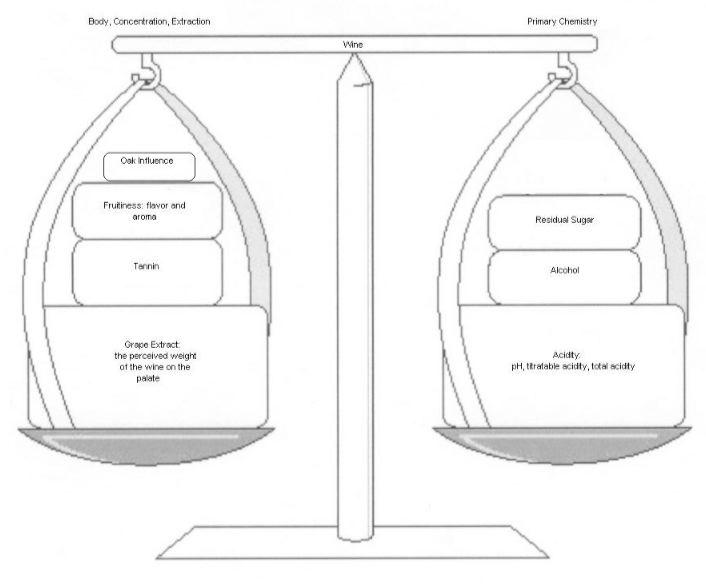 Ted Lemon, Winemaker, Littorai, Sonoma Coast, California. (1) “Both powerful and delicate wines can be balanced. Neither has cornered the market on wine balance. The key is that all elements are in proportion, whether they are in delicacy or in power. Each of us has different sensitivities to all components in wine so for what is balanced for one taster may not be for another. For me a wine is balanced when no element outweighs the others. Wine is most balanced when consumed at the perfect moment of its aging curve when all elements are in perfect harmony. Therefore, wines are not necessarily inherently balanced, but achieve moments of balance during their lifetimes.” (2) “I look for seamlessness in wine. As noted above, it is achieved when no element is out of proportion.” (3) Since wine is not ‘natural’ but a product of human interaction with nature, there is no such thing as a naturally balanced wine. Mastery of the proper moment to pick, of tannin extraction, of whole cluster usage, and a host of other aspects of vinification lead to the potential for balance.” I told Ted I had heard the statement, “If a wine is not balanced initially, it will never be balanced.” Ted’s comment above that wines achieve moments of balance during their lifetime seemed to contradict this. I asked him to reply and I find his answer to be enlightening. “To say that a wine must be balanced initially to be balanced later implies two things. First, that all elements in wine evolve at the same rate, no matter what constituent is involved. Clearly, this is specious because we all know that tannins, for example, tend to decrease over time, but alcohol, for example, does not. Since different constituents change at different rates, a wine that does not appear balanced now may later be so.” “The wine world is full of examples of wines that need time to come into balance: the great Rieslings of Germany, Port, the Chenin Blancs and Cabernet Francs of the Loire from great vintages, traditional Barolo, etc. To claim that wines must start out balanced to be balanced is a convenient way to dismiss wines that don’t fit a simple mode of wine evaluation. If this sounds like a veiled criticism of a certain school of wine reviewers, well I don’t mean for it to be veiled.” “The second implication of the statement that a wine must start out balanced to be balanced is that wine always evolves in ways that are predictable. In other words, it is to deny wine (and Mother Nature) its unpredictability and genius. Wine is alive. It changes, thank the Lord. To say wine must start out balanced is to deny its living nature. Vintages are full of surprises. Ugly ducklings become swans. Swans lose their allure far earlier than we expect.” “I think this myth has grown so widespread for two reasons. One is that it is true that many balanced wines age well and undoubtedly better, on the whole, than wines that do not seem balanced. So in the great scheme of things it is a ‘safe’ statement. The other reason I think, goes back to our beloved Pinot grape. Henri Jayer gained nearly mythological status during his lifetime. While I am an unabashed admirer of Henri’s wines and his philosophy, I don’t think he ever cornered the market on producing the world’s greatest Pinot Noirs. Indeed, the fact that DRC is in the very same village, making wines in a completely different style and yet at least as profound, speaks volumes. Henri’s greatest wines were wonderful. In my mind, his lesser wines were lovely, but not profound. Henri was, as you well know, a huge proponent of this balance idea which then deeply influenced Robert Parker in his youth. Bob loves to point this out.” “There are so many wonderful winemaking styles in the world. No one house has ever got it all right. Some that do very well every year never quite soar to the heights. Even within a vineyard, site expression can change quite dramatically from one year to the next. Some years are more tannic, others softer, others more driven by acidity. Which years are the best years for a given site? Does Thieriot Vineyard do best in the tannic years since it is by nature a more generous wine? Does Hirsch Vineyard do better in the soft years since it is by nature a tannic wine? What about Nuits St. Georges Les Porrets? One could be driven mad by all the different permutations possible. In the end, the terroir-driven winemaker has to step back from such considerations which might lead to radical changes in winemaking from year to year and simply accept to let nature take its course with the winemaker’s gentle guiding hand on the tiller.” “In any tasting of wines of terroir, we face a daunting task. Winemakers are children playing with the gifts of God. When we taste the fruits of their labor, we ask that they step out of the way. We ask that the stumbles and temper tantrums of the vintage, the challenges of harvesting, fermenting, pressing and aging should proceed as smoothly as possible. And we ask that our winemakers should leave behind in the bottle no trace of their failings, but only the beautiful expression of the places where they have been.”
DS. (1) “Balance to me is the delicate confluence of extraction, acidity, tannin and hopefully terroir (that sense of earth/place). Great balance comes across as having substance without excess heaviness, a sense of WEIGHTLESSNESS which is so rare in Pinot!” (2) “The initial aromatics provide a pretty accurate indication of balance. Then extensive swirling and sipping. If possible, let the wine breath and open up. Balanced Pinot will usually open up and get better with air. Ultimately, balanced Pinot is instantly recognizable as a wine I could actually drink with food all day without feeling fatigued after half a glass and just as importantly, not a wine that overwhelms the food!” (3) “Balance is everything to me. Otherwise I feel I’m simply jerking off, wasting my time and money. I think the problem is that the majority of drinkers have no idea what balance is and how to recognize it. Recognizing balance requires years of tasting and being exposed on occasion to balanced wines in start contrast with the majority of West Coast Pinots.” KJ. (1) “Balance is how the fruit, tannins, acidity and alcohol work together.” (2) “Taste and mouth feel determine if the wine is balanced.” (3) “I think balance is innately what one looks for as that is what makes a wine delicious.” ELH-H. (1) “Fruit = Acid.” (2) “If the wine is too hot (too much alcohol) it is unbalanced. If the wine has too much wood or fruit, it is unbalanced.” (3) “YES!” CL. (1) “I feel that a wine is well balanced when no wine feature overpowers another one. Flavors, tannin and acidity all form a perfect harmony.” (3) “I guess so.” AH. (1) “I think of balance as the interplay between the rich and sweet fruit flavors that make wine pleasurable and the structural factors (acid, tannin) that make wine intellectually interesting. A wine too far in either direction can be unpleasant, but a great wine becomes more than the sum of its parts by being in balance.” (2) “I determine if a wine is balanced by tasting it over the course of an evening. Different elements can stand out at different times, so letting the wine breath a little can be important.” (3) I think balance is especially important in Pinot Noir where acid tends to run high. Under ripe Pinots can be over acidic without the fruit to balance.” MS. (1) “Balance in wine is when no one attribute stands out too much. Whether the wine is too oaky, too acidic, too fruity (depending on the varietal), or not fruity enough, or overpowered by winemaking techniques such as malo.” (3) “I look for balance in every wine I taste. If there is oak, then I prefer just hints of the essences of oak (caramel, nutmeg, vanilla, etc.) and dislike the wine to taste like oak chips. There is nothing I hate more (and it happens all the time) when I buy a $100 bottle of Pinot, open it at dinner, and have it taste like fruit at first, then an overwhelming finish in caramel candy. It ruins my experience of the wine because I ordered Pinot to pair with my meal and to complement it, not to have it taste like candy.” DS. (1) “For me personally, a balanced wine contains the right and appropriate fruit flavors, oak (or not), alcohol, acidity and pH from the moment we sniff, fill our mouths and swallow. All are very well integrated and each layer of flavor is perfectly matched.” (2) “Sniff, swirl and sip. A balanced wine is bright, enticing with a wonderful and full mouth feel and each component not overpowering the other: harmonious from start to finish.” (3) “Absolutely. If a wine is disjointed or seemly unbalanced, my tongue is not pleased, nor is it a pleasant or memorable experience. For me, wine is about the experience, the company, the food and the total feeling. What makes for even a more rich wine experience is having a well-balanced wine excellently paired with a meal shared by friends and family.”
PinotFile CenterfoldOccasionally the PinotFile features a woman passionate about Pinot Noir as a Centerfold. This issue’s Centerfold Pinup is Kerith Overstreet, M.D., winemaker, and co-owner with spouse Brian Overstreet of Bruliam Wines. She wears the pants in this winery. Bruliam Wines released their first Pinot Noir in 2008, and in 2009 produced righteous single-vineyard Pinot Noirs from the Santa Lucia Highlands, Sonoma Coast and Anderson Valley. Kerith and Brian contribute humorous posts on their blog which is required reading for pinotphiles at www.bruliamwines.com. Like me, Kerith has discarded her voluminous medical books, retired from the practice of medicine, and has allowed her Pinot passion to take over. She also likes bacon.
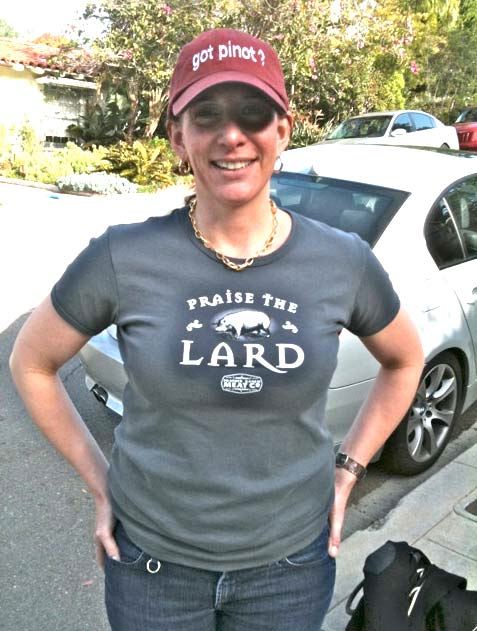
Noiregon: First Look at 09s and Late Release 08sThe Oregon Wine Board, in its 2009 Oregon Harvest Roundup, reported that the harvest period began warm and dry, but then cooler weather prevailed in late September and early October. A three day late September heat spike pushed the sugar levels up, concentrating flavors and hastening harvest. Winemaker Harry Peterson-Nedry of Chehalem commented: “There is a personality to each vintage, a pedigree made of weather and terroir that is both intellectually and hedonistically interesting. This (2009) vintage is similar to 2002, with good weather during harvest and lots of fruit. Pinot Noirs will be flashy and spectacular this year.....with great wines in good quantity.” Scott Wright of Scott Paul Wines said, "A worthy successor to the magnificent 2008 vintage, 2009 in Oregon will go down as a delicious vintage of pure pleasure. The wines are rich, fruity and succulent, and ready to give immediate pleasure and the instant gratification that we all crave from time to time. I don't think the '09s will be as long lived as their '08 predecessors." According to the USDA National Agricultural Statistical Service (reported in Oregon Wine PressApril 2011) overall tonnage in 2009 was 40,300, 16 percent larger than in 2008. Roughly 1.37 million cases of wine were produced in Oregon in 2009. When I tasted some of the 2009 Willamette Valley Pinot Noirs out of barrel last summer, I was impressed at how precocious and gregarious the wines were. Alcohols are higher, but the wines have bodacious flavor. Unlike another ripe vintage, 2006, the wines appear to have better acidity and freshness. Williamette Valley Pinot Noirs from the 2008 vintage continue to be released into the marketplace. The 2008 Pinot Noirs are magnificent, but reluctant wines that need time to evolve. Producers who were able to keep the wines in bottle for an extended time are offering wines that just now are approachable. The most sage advice I can give you is to stock your cellar with all the 2008s you can afford, and forget about them for a couple of years while you drink the 2009s.
2009 Westrey Willamette Valley Pinot Noir 13.5%, $19. · Moderate plum color in the glass. Aromas of black plums, prune juice and oak. Dark fruits are featured that have a ripe, cooked quality. Soft with supple tannins and a silky finish. Decent.
2009 St. Innocent Villages Cuvée Willamette Valley Pinot Noir 13.5% alc., 2,640 cases, $20. 54% Vitae Springs Vineyard with fruit from young vines elsewhere (22% Zenith Vineyard and 24% Momtazi Vineyard). 2- day cold soak, fermented in stainless steel tanks, aged 12 months in 15% new French oak barrels. Unfined and unfiltered. Winemaker Mark Vlossak. · Moderately colored in the glass. Dark red fruit aromas are buried in scents of wood shed, oak and brier with a whiff of alcohol evident. Red-fruited on the modest palate with a savory bent and oak in the background. Very soft in the mouth with adequate tannic support. Decent.
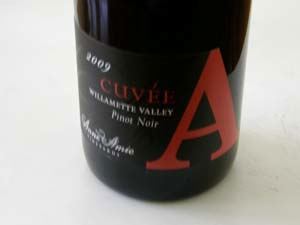 2009 Anne Amie Cuvée A Williamette Valley Pinot Noir 13.8% alc., pH 3.60, TA 0.59, 3,770 cases, $25. Release date is May, 2011. A blend of grapes from eight vineyards including some estate fruit. Clones 115, 667, 777, 828, Pommard 4 and 2A. Willakenzie and Laurelwood soils. Aged 10 months in 16% new, 18% 1-year old, and 66% neutral French oak barrels. 100% de-stemmed, extended cold soak and maceration (on skins 28-40 days), free run and press juice combined. Aged 6 months in bottle before release. · Subdued aromas upon opening, evolving in the glass to reveal attractive scents of cherries, mixed berries, oak and roses. A wine that aims to please with its easy drinking cherry, cranberry, grape soda flavors wrapped in supple tannins and framed by lively acidity. A solid back porch pounder that is ready to go now. Good (+).
 2009 Westrey Oracle Vineyard Dundee Hills Pinot Noir 13.5% alc., $26. · Moderate reddish-purple color in the glass. The nose is slow to emerge, but over time becomes flamboyant, displaying hitone aromas of black cherries. The most intensely flavored and structured of the three Westrey Pinot Noirs reviewed here, with plenty of black cherry and spice pleasure, ripe well-proportioned tannins, and a refreshingly juicy finish. Very Good.
2009 Westrey Abbey Ridge Vineyard Dundee Hills Pinot Noir 13.5% alc., $32. · Moderately light reddishpurple color in the glass. Bright aromas of cherries, strawberries with hints of oak and dried herbs. Tasty array of red fruits with notions of spice and cola. Crisp and charming, soft and elegant, with supple tannins. Rather simple but well-crafted and blessed with finesse. Good.
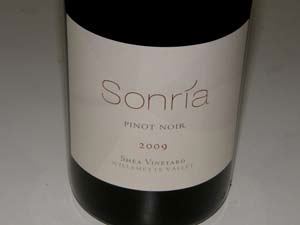 2009 Sonría Shea Vineyard Yamhill-Carlton District Pinot Noir 14.4% alc., 180 cases, $60, released January 29, 2011. Keith and Stacy Emerson named their label Sonría after their daughter Aubrey’s smile. Sonría is derived from the Spanish verb Sonreír which means, “To smile.” Keith is a graduate of U.C. Davis, the Director of Winemaking at Vineyard 29 and its custom crush clientele, and Stacey is a 10-year veteran of the wine industry with a focus on marketing. This wine is made from Pommard and Wädenswil clones, processed at Vineyard 29 in St. Helena. Aged 11 months in 50% new and 50% once-used French oak barrels. · Moderate reddish-purple color in the glass. The aromatics are nicely fruited with appealing complimentary scents of spice, dried roses and a hint of spearmint. A hearty layered core of blackberry, black raspberry and cherry fruit impresses the mid palate and lingers aromatically on the finish that has a slight confected note. The oak is well integrated, an attractive spiciness prevails, and the mouth feel is dreamy. Still sporting ripe, firm tannins that will benefit from a year or two in the cellar. This wine will fortify the already admirable reputation of Shea Vineyard. Very Good.
2008 Johan Vineyards Willamette Valley Pinot Noir 13.3% alc., 396 cases, $28. Aged 18 months in French oak barrels. · Subdued aromas of cherries and berries with oak and spice in the background. Very tasty pop on the mid palate of red plum and red and black berry fruits wrapped in firm tannins. The flavors trump the aromas at this stage. The wine should shed its tannic muscle over time and I suspect this will improve with another year or two in the cellar. Good (+).
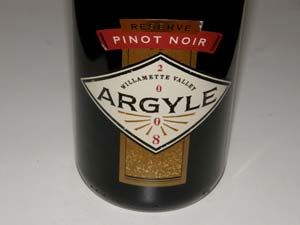 2008 Argyle Reserve Willamette Valley Pinot Noir 14.0% alc., 700 cases, $30, screw cap. The best vineyard blocks from Argyle-farmed properties. · Attractive aromas of black cherries, grilled mushrooms, and forest floor. Moderately intense core of dark red berries nicely framed by a hint of oak and a healthy tannin backbone. Closed upon opening, but gradually coming to life over time in the glass with more fruit intensity and spice coming to the forefront. Even better the next day from a previously opened and re-corked bottle. This wine should definitely be aged in the cellar and has the balance to succeed.
2008 Colene Clemens Vineyards Estate Reserve Chehalem Mountains Pinot Noir 13.5% alc., 440 cases, $36. Inaugural release (along with an Estate bottling) from a 23-acre estate vineyard planted in 2006 in the Ribbon Ridge AVA. The winemaker is Steve Goof, who spent several years as an assistant to Beaux Frères winemaker Mike Etzel. Clones are 115, 667, 777 and Pommard. Aged in 50% new French oak barrels. · The nose is dominated by oak with very little fruit to the front. Discreetly intense flavors of black cherries with prominent accents of grilled mushrooms and toasted oak. The tannins are restrained, and the texture is satiny, but there is too much oak on board now. The oak may integrate over time, but I suspect this will always be an oaky wine. Decent.
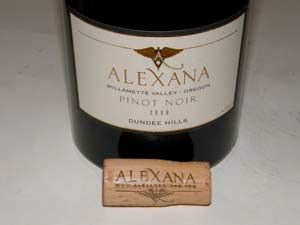 2008 Alexana Dundee Hills Willamette Valley Pinot Noir 13.8% alc., $38. Six clonal selections from microblocks in the Revana Vineyard. Proprietor Dr. Madaiah Revara bottles several Pinot Noirs under the Alexana label, a tribute to his daughter, Alexandra. The winemaker is Lynn Penner-Ash. · Moderate reddish-purple color in the glass. Nuanced perfume of strawberries, red cherries, spice, vanilla, biscuit and oak. Delicious array of red berry and red stone fruits with a pop of cherry on the finish. A seductive, silky wine that really shows off the red fruit character of the Dundee Hills. Has the balance to last in the cellar. Very good (+).
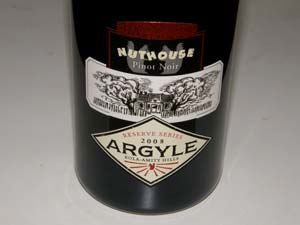 2008 Argyle Nuthouse Reserve Series Eola-Amity Hills Willamette Valley Pinot Noir 14.0% alc., 3,200 cases, $42, screw cap. Named for the old hazelnut drying facility or nuthouse which is now the Argyle winery. Composed of carefully chosen vineyard blocks with pedigree. · The nose is reserved, offering delicate aromas of dark stone fruits and berries with complimentary oak. Vivid and intense red and black berry compote on the palate including a striking attack of black raspberry fruit on entry that lingers on the finish. Well-rounded, smoothly textured, with a lively acid underbelly. More approachable than the 2008 Argyle Reserve, but will also benefit from cellaring. Impressive!
2008 Anne Amie Prismé Willamette Valley Pinot Noir Blanc 14.1% alc., $47. · Pale yellow-straw color in the glass. Similar aromatic profile to the 2007 vintage but less evolved and opening slowly in the glass. Perfume of pears, pastry cream, confected nuts and toasted bread. Very creamy on the palate with subdued but appealing flavors of hazelnuts, caramel corn, citrus, vanilla, and white stone fruits. Bright acidity with supple tannins. Give this more time in the cellar for full expression. Very good.
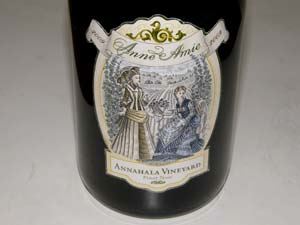 2008 Anne Amie Anahala Vineyard Anderson Valley Pinot Noir 14.1% alc., $50, screw cap. A Fall 2011 release. This is an unusual offering: an Oregonmade Pinot Noir sourced from Anderson Valley. Winemaker Thomas Houseman’s winemaking career began in the Anderson Valley, he was used to working with Anderson Valley fruit, and when a few tons of grapes became available, he said, “Why not?” Remember, Anderson Valley is often referred to as “Baja Oregon.” · Moderate reddish-purple color in the glass. Scent of oakimbued black cherries and dark red rose petals. Discreetly concentrated core of dark red berries and cherries with a subtle smoky oak underpinning. Softly textured with restrained tannins and highly charming as well as approachable now. Very good.
2008 Anne Amie L’iris Willamette Valley Pinot Noir 13.5% alc., pH 3.52, TA 0.62, 210 cases, $75, screw cap. 34% Anne Amie Estate, 55% Twelve Oaks Estate, 11% Hawk’s View Vineyard. Pommard, Wädenswil, 114, 667 and 777. Aged 18 months in 33% new, 67% 1-year old French oak barrels. Willakenzie and Laurelwood soils. Extended bottle aging. Unfined and unfiltered. · Moderately deep ruby hue in the glass. Aromas of black cherries, spice, wooded forest and slight oak char. Tasty core of black cherry, cranberry and raspberry fruit with hints of spice, chocolate, loamy earth and oak. Light and elegant with a clinging intensity that hangs on through the long finish. Bright acidity with restrained fine-grain dusty tannins. Exhibiting a noticeable dose of oak upon opening but integrated over night when re-tasted the next day. Good now, but will reward even more patience.
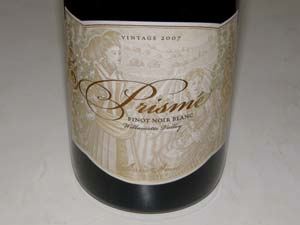 2007 Anne Amie Prismé Willamette Valley Pinot Noir Blanc 14.1% alc., 390 cases, $45. A serious wine made from some of the winery’s finest vineyard blocks. Grapes are gently pressed, liberating the freerun jjuice, but not the color or tannins from the skins. Barrel fermented and aged on the lees in French oak barrels fro 18 months. · Moderate straw color in the glass. Complex aromatic profile that changes constantly in the glass offering scents of banana peel, lemon, lychee, pear, browned banana and roasted nuts. A red wine masquerading as a white wine. Delicious and creamy in the mouth with a Baskin-Robbins array of flavors including cream soda, Asian pears, cooked banana, white peach, honey and nutty butter. Hard to describe and clearly unique with the bright acidity displaying the fruit notes beautifully. You can have plenty of fun with this wine which has picked up considerable interest since tasted last year. Not cheap, but well-worth the tab considering the intense production methods employed and the quality of the wine.
Cobb Wines: Carrying On the Williams Selyem Style TraditionWinemaker Ross Cobb trained under the master, Burt Williams, as well as the current talented winemaker at Williams Selyem, Bob Cabral. Cobb had a distinguished stint as winemaker at Flowers Vineyards & Winery from 2004 to 2008. As the current winemaker for Cobb Wines, he has partnered with his father, David Cobb, who along with his former spouse, Diane (who is deceased), established Cobb Wines in 2001. Six distinct vineyard-designated Pinot Noirs are produced at Cobb Wines: Coastlands Vineyard and Coastlands Vineyard Diane Cobb, Rice-Spivak Vineyard, Joy Road Vineyard, Jack Hill Vineyard, and Emmaline Ann Vineyard, all located in the cool reaches of the Sonoma Coast. Ross notes, “The differences between the wines are all vineyard driven: all about site and farming choices. We don’t manipulate the wines in the winery to make them different. Instead, we custom prune and manage each vineyard.” The Cobbs farm the 15-acre Coastlands Vineyard which was planted by David and Diane Cobb in 1989 and today contains some of the oldest Pinot Noir vines on the true Sonoma Coast. The vineyard is located at an elevation of 900 to 1,200 feet on a ridge overlooking the Pacific Ocean. The marine wind and fog at the site keeps yields low (well under 2 tons per acre). The 2008 Coastlands Vineyard Pinot Noir is the eighth vintage of Cobb’s flagship wine. The special Diane Cobb bottling comes exclusively from a nursery block at Coastlands that Diane Cobb planted to numerous relatively unknown Pinot Noir varieties with the goal of determining what varieties performed best at this site. The wine commemorates Diane’s life at Coastlands. It is a co-ferment of the 24 most successful selections of Pinot Noir from the Diane Cobb Block.
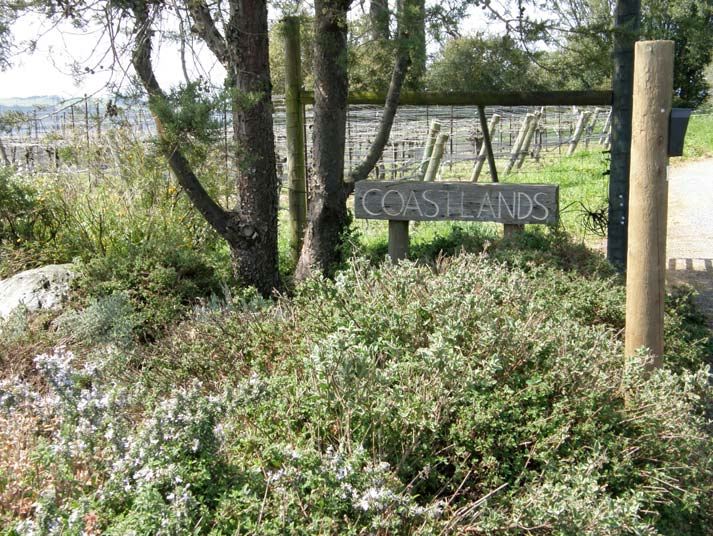 The 2006 and 2007 vintages of Cobb Pinot Noir were the first I really got my teeth into and I was stunned by the quality of wines. I awarded my highest accolade, the Pinot Geek, to every Cobb Pinot Noir reviewed from those two vintages. I find the wines among the closest currently being produced in California to the paradigm fostered by iconic vintner Burt Williams. Cobb wines are complex, aromatic and lower in alcohol. They are picked at lower brix, and aged with a modest amount of new French oak to preserve their terroir-driven character. The 2008 vintage lineup, reviewed below, carries on the tradition. All the wines are moderately light in color in the glass, but don’t let this lessen your anticipation for it will certainly not diminish your enjoyment. The wildfire smoke which affected the more northerly Sonoma Coast vineyards, did not encroach on Cobb’s vineyard sources. 2008 was a cool vintage which played to the style of Pinot Noir made at Cobb. Cobb wines are sold almost exclusively through a mailing list and an online store at www.cobbwines.com. Library wines are offered as well.
2008 COBB Coastlands Vineyard Sonoma Coast Pinot Noir 13.6% alc., 260 cases, $68. Aged 17 months in 35% new French oak barrels. · Cherries and red plums are featured on the nose with a hint of dark chocolate. A red fruit theme is offered in a style of welcoming finesse with a pleasing citrusy acid lift bringing the cherry and raspberry flavors to life. A little grilled mushroom, smoky oak and sauvage adds to the appeal. The tannins, which are typically firm in wines from this vineyard, are well corralled, but will soften further with more time in the bottle. Very good.
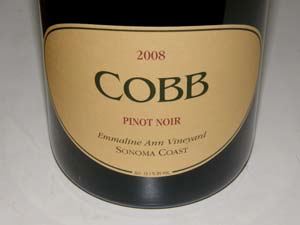 2008 COBB Emmaline Ann Vineyard Sonoma Coast Pinot Noir 13.1% alc., 360 cases, $68. From 3-acre vineyard near Occidental planted to Dijon clones in Goldridge sandy loam. · Very enticing aromas of dusty dark red spiced Pinot fruits with faint notes of oak and cinnamon. Luscious and silky body of red plum and dark red berry fruits make an impression on the mid palate and linger with a vengeance on the generous finish. Beautifully balanced with racy acidity and supple tannins, this wine offers a little more richness than others in the lineup, but displays the finesse that Cobb wines are known for. A keeper.
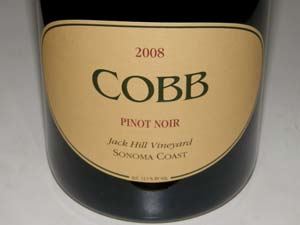 2008 COBB Jack Hill Vineyard Sonoma Coast Pinot Noir 13.5% alc., 240 cases, $68. From a 2-acre hillside vineyard near Occidental a few miles from Coastlands and Emmaline Ann vineyards. Dijon clones 115, 667 and 828 planted in Goldridge sandy loam. Hand-tended by the couple living on the property. Aged 17 months in 35% new French oak. · Demure aromas of cherry and berry fruits nicely spiced and accented by underbrush. Absolutely delicious melange of fresh cherries and berries with complimentary hints of spice, oak and minerality. Juicy, with impressive persistence on the finish. A lighter bodied wine with gossamer tannins that has a very appealing and seductive gentleness. An All-American.
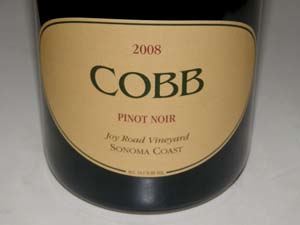 2008 COBB Joy Road Vineyard Sonoma Coast Pinot Noir 14.1% alc., 280 cases, $68. From a 2-acre vineyard near the Coastlands Vineyard. Closespaced planting of a mix of Pinot Noir clones in sandy loam soils. Aged 17 months in 35% new French oak. · A remarkably intense cherry aroma develops over time in the glass. Scents of toasted oak and candied apple contribute interest. A charmer that unfolds in stages, revealing vibrant black cherry and ripe strawberry flavors with undertones of sandalwood and vanilla. Soft and silky and seductive. Very good.
2008 COBB Rice-Spivak Vineyard Sonoma Coast Pinot Noir 13.5% alc., 450 cases, $68. A 6-acre vineyard near Sebastopol planted in Goldridge sandy loam laced with volcanic ash. Dijon clones and Swan selection. Aged 17 months in 35% new French oak barrels. · Intensely aromatic showing vivid aromas of black cherries and black raspberries with hints of earth and oak. A little restrained upon opening, later revealing a core of racy dark red and black fruits with a refreshing lift of citrus peel on the finish. Showing a subtle caramel note from the oak which should integrate over time. Elegant and refined, with supple tannins. Very good.
2008 COBB Coastlands Vineyard Diane Cobb Sonoma Coast Pinot Noir 13.7% alc., 160 cases, $78. · This is a very curious wine. When tasted upon opening, it had a disagreeable smoky, tarry tone to the aromas and flavors. When re-tasted 24 hours later from a previously opened and re-corked bottle, it had undergone a remarkable transformation from an ugly duckling to a monarch. My comments are from the next day. Very appealing spicy black cherry aromas. Generous cherry and plum flavors with a velvety mouth feel and a kicking acidity on the finish. A subtle undertone of smoke and tar detracts only slightly from this wine. Your enjoyment will depend on your tolerance for smoke taint. Good.
Papapietro Perry: Stellar Lineup in 2008Ben Papapietro attributes his passion for Pinot Noir to a friendship he shared with vintner Burt Williams of Williams Selyem fame while both were working at the San Francisco Newspaper Agency in the 1970s. Ben began helping Burt make his wine at home and continued to work each harvest at Williams Selyem after the winery was launched in the early 1980s. Ben began making his own garage wine in 1980, and a few years later was joined by Bruce Perry, another fellow worker at the San Francisco Newspaper Agency. Their garage wines were beloved by family and friends leading them to start Papapietro Perry in 1998 with a release of 75 cases of Pinot Noir. Today, the pair, along with their spouses, Yolanda Papapietro and Renae Perry, produce 6,000 cases of appellation-designated, vineyard-designated and clonal-designated Pinot Noir from prime vineyards in the Russian River Valley and Sonoma Coast. They also craft small lots of Zinfandel and a limited production Chardonnay (100 cases) from Peters Vineyard. Bruce (left) and Ben during their garagiste days are pictured on the left. Bruce and Renae (left), Ben and Yolanda (right) in their winery on the right.
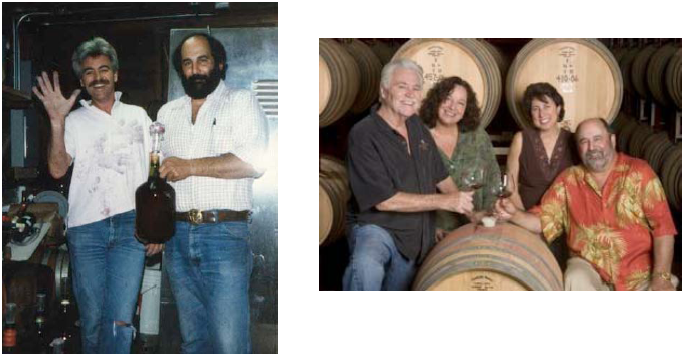 I recently stopped in at the welcoming Papapietro Perry Tasting Room on Dry Creek Road in Healdsburg and sampled the lineup of 2008 Pinot Noirs. I was able to meet growers Nick Leras and Randy Peters and talked at length with them, primarily about restoring old cars! I also re-tasted the Leras Family, Peters Vineyard and Pommard Clones Pinot Noirs at home. The wines impress, not only for their individuality, but for their food friendly bent. The wines straddle the middle ground between voluptuous big-boned styles and classic, delicate examples of Pinot Noir. Winemaking is traditional beginning with a 2-4 day cold soak, inoculation with Pinot Noir appropriate proprietary yeasts, hand punch downs, and aging in Francois Frères oak barrels for 11 months with the percentage of new oak varying depending on the vineyard source. Bruce feels the 2008 vintage is more restrained, slightly less deep in color, and less concentrated than the 2007 vintage, but has its own appeal. The recommended best drinking window for the 2008 Pinot Noirs is now through 2015, but some wines will age well beyond this. The two couples are extremely receptive to visitors, harboring no signs of pretentiousness, so typical of family owned wineries in Sonoma County. They do not take their wines too seriously (one of their tee shirts sports the slogan, “So good you’ll want to swallow”) but the wines are seriously good. The Papapietro Perry lineup of wines is available through the winery’s website (www.papapietro-perry.com) and limited retail channels. The best way to climb on board is through the winery’s Wine Club which offers significant discounts and benefits. Magnums are available.
2008 Papapietro Perry Russian River Valley Pinot Noir 14.5% alc., pH 3.68, TA .623, 1,220 cases, $46. A blend of five vineyards. 30% new, 50% 1 and 2-year old and 20% 3-year old French oak. · Lovely aromas of red Bing cherries with hints of herb garden. Moderately rich with a pleasing array of spicy cherry, cranberry and raspberry fruits. Gossamer tannins make for a silky drinking experience. Good.
2008 Papapietro Perry Sonoma Coast Pinot Noir 14.5% alc., pH 3.53, TA .633, 780 cases, $46. From Gap’s Crown Vineyard in the Petaluma Gap. Aged 11 months in 50% new and 50% 1 and 2-year old French oak. · Shy perfume of black cherries and spring herbs. Bright and savory, with a light-weighted core of dark cherry and berry flavors. Good.
2008 Papapietro Perry Elsbree Vineyard Russian River Valley Pinot Noir 14.5% alc., pH 3.63, TA 0.570, 730 cases, $49. A mix of clones on varied rootstocks. Aged in 50% new and 50% 1 and 2-year old French oak. · Enticing aromas of dark cherries, anise and wet bark. Hi-tone melange of fresh cherries and berries wrapped in ripe, firm tannins and finishing with an intense aromatic berry note that lingers. Admirable finesse. Very good.
 2008 Papapietro Perry Leras Family Vineyards Russian River Valley Pinot Noir 14.5% alc., pH 3.66, TA 0.701, 1,020 cases, $54. Pommard and Dijon 115, 667, and 777 clones. The Pommard is about 13 years old.Aged 11 months in 50% new and 50% 1 and 2-year old French oak. · Very lovely perfume of Bing cherries, red roses and spice box with a subtle with a subtle notion of oak. Medium-weighted flavors of black cherries, ripe berries, cola and sassafras. Fruit flavors veer to the ripe side but remain in tune. Silky and charming with fine-grain tannins. Very good.
2008 Papapietro Perry Nunes Vineyard Russian River Valley Pinot Noir 14.5% alc., pH 3.61, TA 0.619, 295 cases, $54. Inaugural bottling from this vineyard farmed by Fred Nunes. Vines are about 12 years old. Aged 11 months in 50% new and 50% 1 and 2-year old French oak. · Spectacular aromatics featuring an onslaught of fresh cherry tart scent. Discretely concentrated core of spiced cherries with moderate ripe tannins, a touch of herbal oak, and noticeable persistence on the finish which leaves a touch of heat in its wake. Good.
 2008 Papapietro Perry Peters Vineyard Russian River Valley Pinot Noir 14.5% alc., pH 3.74, TA 0.57, 900 cases, $54. This vineyard is a few miles west of Sebastopol on the edge of the newly expanded Russian River Valley appellation. Aged 11 months in 50% new and 50% 1 and 2-year old French oak. · Nicely perfumed with oak-scented dark red berries and cherries, a roseate note, and hints of anise and smoke. Considerable flavor impact on entry, lingering on the fruity finish. Tasty spiced cherry and berry fruit underlain with restrained oak, and enrobed in restrained fruit tannins creating a welcoming elegance and silky texture. This wine has interest beyond the fruit. Very good (+).
2008 Papapietro Perry 777 Clones Russian River Valley Pinot Noir 14.5% alc., pH 3.64, TA 0.676, 440 cases, $70. Aged 11 months in 80% new, 20% 1 and 2-year old French oak. 777 clones from six vineyards. · Appealing perfume of crushed black cherries and raspberry coulis. Earthy and darkly fruited on the palate with a tea and herbal accent. Generous tannins beg for protein (short ribs or steak). Good (+).
 2008 Papapietro Perry Pommard Clones Russian River Valley Pinot Noir 14.5% alc., pH 3.75, TA 0.66, 440 cases, $70. Sourced from Leras Family Vineyards and Peters Vineyard. Best three barrels from each source. Aged 11 months in 90% new and 10% 1-year old French oak. Third bottling of this clonal mixture. · Moderately light reddish-purple color in the glass. Bold and fruity nose picking up intensity with time in the glass, showing accents of vanillin and oak. Luscious and vivid black cherry and black raspberry fruit that really makes an impression. The most intensely flavored wine in the lineup, but also nuanced with contributing flavors of cola, spice, confection and vanilla. A fantastic match with lamb. Clearly the star of this vintage.
2008 Papapietro Perry Mukaida Vineyard Russian River Valley Pinot Noir 14.5% alc., pH 3.77, TA 0.611, 195 cases, $75. The 8 best barrels from Peters Vineyard. Aged 11 months in 90% new and 10% 1-year old French oak. · An earthy and savory nose leads to a charge of cherry and berry fruit in the mid palate persisting on the generous finish. A gentle, elegant wine that packs a punch. Will benefit from more time in the cellar. Very good.
Couloir Wines & Straight Line WineWinemaker Jon Grant attended college in the heart of the Finger Lakes wine region in New York, but his real introduction to wine occurred while living and working in Snowbird, Utah, at Snowbird Ski Resort. His first job was in the beverage department at Snowbird working for Vicky Martinez who was to become his first mentor and opened his eyes to the world of wine. Also, Snowbird hosted the only wine festival in Utah and it was at these events that Jon was able to mix with members of the wine industry including winemakers, winery owners and distributors. Grant eventually found his way to Napa Valley, landing a job at Robert Mondavi Winery as an ambassador for the winery. He was afforded cross-training in viticulture and winemaking and attended extension classes offered by University of California at Davis and Napa Valley College to further his winemaking and winegrowing knowledge. Jon later worked at Corison, PlumpJack and Turley Wine Cellars, and became part of the Napa wine community. Each new position added to his experience, leading him to find a personal style of wine that most suited him. He chose to make Pinot Noir because he wanted a variety that was terroir-driven, that was a good partner at the table, offered aromatic intensity and responded to minimal intervention. Although he has now worked eleven years at Turley Wine Cellars, which specializes in Zinfandel, he produces Pinot Noir, Tempranillo and Syrah under his Couloir Wines and Straight Line Wine labels. Combining his passions for skiing and wine, the word, “Couloir,” refers to a steep mountainside gorge. Both of his labels are under the Grant Family Wines umbrella company. Jon believes in the judicious use of whole cluster, spontaneous fermentations, and a gentle touch of French oak. He avoids racking, fining and filtering as he finds this winemaking regimen leads to bright, fresh flavors and complex, harmonious flavors. The goal is aromatic and flavor intensity without concentration. I was impressed with Jon’s Pinot Noirs from the first taste of 2007 barrel samples at the 2008 Anderson Valley Pinot Noir Festival. I recently sampled the 2009 lineup of Couloir Pinot Noirs as well as the 2009 Straight Line Pinot Noir which offers solid value-priced drinking. Jon has top notch vineyard sources and he knows what to do with the fruit. All the wines show off their terroir beautifully with a distinctiveness that is welcoming. Jon is a young Pinot Noir turk that is turning out remarkable wines after only three vintages and the entire lineup is very impressive. Like Jon, I am a devotee of whole cluster vinification. Jon’s vineyard-designated Couloir Pinot Noirs are sourced from the following Mendocino County vineyards. Londer Vineyard is located in the Deep End of the Anderson Valley, tucked away in a forest of conifers with a combination of well-drained sandy loam over clay loam. Monument Tree Vineyard was planted in 1999 to Dijon clones and is now owned by Twomey Cellars located in the Russian River Valley. The low-vigor site has a desirable northeastern sloping exposure with 300 foot elevations. Roma’s Vineyard is located at 1,850 feet. Pommard clone is planted in Goldridge loam soils and is organically farmed. Oppenlander Vineyard has a heavy clay loam soil unique to the region. Situated north of Anderson Valley and eight miles from the Pacific Ocean, this vineyard has a significant maritime influence. Pommard and Dijon clones are planted. A single Marin County source is Chileno Valley Vineyard located on the southern edge of the Petaluma Gap. The vineyard is heavily influenced by the Pacific Ocean along Marin’s west coast and San Pablo Bay on Marin’s eastern flank. The cool maritime climate leads to a very long growing season. Soils are eroded sandstone and Steinbeck series. The vines are a mix of Pinot Noir selections and clones. The wines are sold through the online store at www.couloirwines.com. The website is very informative. The 2009 Couloir Londer Vineyard Pinot Noir is sold out. Be sure to seek Jon out at this year’s Anderson Valley Pinot Noir Festival Grand Tasting, May 21 (www.avwines.com). The label and packaging of the wines is striking. Prices are sensible.
2009 Straight Line Anderson Valley Pinot Noir 13.9% alc., pH 3.76, TA 0.58, 660 cases, $28. 40% whole cluster. Sourced from Monument Tree, Roma’s, Londer and Oppenlander vineyards. · Moderate ruby color in the glass. Deep aromas of dark red cherries and raspberries. Medium-weighted core of juicy red cherry, berry and plum fruits wrapped in mild dry tannins, augmented with subtle spice and oak, and sporting bright acidity. Good.
2009 Couloir Chileno Valley Vineyard Marin County Pinot Noir 13.2% alc., TA 0.57, 90 cases, $38. 33% whole cluster. · The nose initially offers scents of black cherries, mixed berry jam and spice evolving over time in the glass to reveal more intense fruit aromas and hints of grilled mushrooms and brioche. Tasty cherry and cranberry flavors on a medium frame with a faint earthy, tarry note, brought to life with vibrant acidity that leads to a refreshing finish. Toasty oak plays a supportive role in the background. A well-crafted wine that was even better the following day from a previously opened and re-corked bottle. Good (+).
2009 Couloir Londer Vineyard Anderson Valley Pinot Noir 13.6% alc., pH 3.75, 117 cases, $38. 33% whole cluster. · Deeply colored in the glass. Subdued, but pleasing aromas of fresh berries, spice, oak and grilled mushrooms. Noticeably intense and concentrated with a tasty array of red and black fruits underlain with an earthy, savory, sassafras tone. A bit closed, but grows on you over time in the glass. Well-proportioned, softly coating tannins. Very smooth on the palate, ending with an hi-tone mixed berry note. Balance is spot on.
2009 Couloir Monument Tree Vineyard Anderson Valley Pinot Noir 14.1% alc., pH 3.71, TA .54, 143 cases, $38. 33% whole cluster. Dijon 777, 667 and 115. Aged in 33% new French oak barrels. · The aromas are striking showing off perfectly ripe black cherries, black raspberries and a hint of pine. Strikes a chord from entry to finish, with a vivid core of cherry and berry fruit that is just plain delicious. The moderate tannins are beautifully proportioned, the mouth feel is delicate and sensual, and the wine is impeccably balanced. This sexy, irresistible wine has the whole package.
2009 Couloir Oppenlander Vineyard Mendocino County Pinot Noir 13.5% alc., pH 3.52, TA 0.61, 118 cases, $38. 50% whole cluster. 50% Pommard and 50% Dijon 115 clone. · Aged in 40% new French oak. I have never had a bad wine from this vineyard and this Pinot Noir is no exception. Moderate reddish-purple color in the glass. Black cherry and blackberry aromas which are subdued. Impressive essence of dark plums and berries with some soul and grip, encased in plentiful grainy tannins, and persisting on a fruit-filled, earthy finish. The tannins should smooth out over time, but this will always be a firmly structured wine. The key to enjoying this wine is pairing it with hearty food and I had this wine with my home made buffalo chili the next day from a previously opened bottle and the match was heavenly. Very good (+).
2009 Couloir Roma’s Vineyard Anderson Valley Pinot Noir 14.0% alc., TA .56, 145 cases, $38. 50% whole cluster. Pommard clone now approaching 20 years of age. · Flamboyant aromas of red Bing cherries and sandalwood. Plenty of red cherry flavors, clove, other spice and everything nice. The lightest weighted wine in the lineup with less concentration but still packing plenty of flavor. Supple tannins, faint oak, and an appealing citrus note in the background. Totally different from the other wines and isn’t that perfect? Very good (+).

Newest Releases from TalismanI am a big fan of Scott and Marta Rich’s Pinot Noirs and have told their story several times in the PinotFile. I recently reviewed three of their 2007 releases (Gunsalus Vineyard, Wildcat Mountain Vineyard, and Hawk Hill Vineyard). See the reviews at www.princeofpinot.com/winery/447/. There are several notable features of Talisman Pinot Noirs. First, the wines come from expressive and unique terroirs that are beautifully displayed in the wines. Second, the wines are not released until they are ready, often a year after other wineries released their newest vintage. The wines are given a minimum of one year in bottle before release. Third, the wines are very age worthy. I recently sampled three new releases (April 1, 2011) from Talisman and they were in step with previous wines I have thoroughly enjoyed. All the wines are moderately big-boned and generously fruited, but they are nicely balanced and texturally pleasing. All are raised in a high percentage of new French oak, but the source of the fruit and the concentration demands it, and none of the wines have a distracting oaky presence. The wines were bottled in August 2009. Prices are sensible. Talisman Pinot Noirs are sold through a mailing list. The small winery is in an industrial space in the town of Sonoma and is open for tasting by appointment only (707-258-5722).
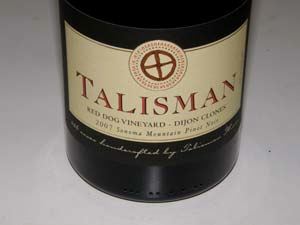 2007 Talisman Adastra Vineyard Los Carneros Pinot Noir 14.3% alc., pH 3.76, TA 0.55, 193 cases, $46. From a Certified Organic vineyard planted in 1994 that Rich has worked with for many years dating back to his days at Etude. Farmed by Chris Thorpe and his son-in-law Edwin Richards. All clones (Swan, Pommard, Dijon 113, 2A) co-fermented, 25% whole cluster, natural fermentation. Aged in 86% new French oak barrels from several prominent coopers and bottled after 20 months in barrel. · Moderately dark reddish-purple color in the glass. The nose opens slowly to reveal bright aromas of red and black berries, stone fruits, dried rose petals and subtle oak. Subdued and mysterious in the mouth, with a healthy core of black cherry and black plum flavors with a little red fruit mixed in. Still tight with healthy tannins, but has an appealing softness and a charming earthy appeal. Drink with hearty protein now, or cellar for an even better experience. Very good.
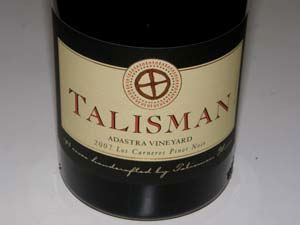 2007 Talisman Red Dog Vineyard Dijon Clones Sonoma Mountain Pinot Noir 14.3% alc., 256 cases, $46. Dijon clones 115 and 777. 25% whole cluster, wild fermentation, post-fermentation maceration, aged 20 months in 69% new French oak barrels. This vineyard is located high above Bennett Valley at 1,200 feet on the northwestern side of Sonoma Mountain. · Deep reddish-purple color in the glass. Enticing perfume offering many nuances including crushed dark red fruits, smoked meat, spice and subtle oak. Striking flavors of raspberries, black cherries, ripe strawberries and smoky oak. Smooth and seductive in the mouth, lingering with a refined aromatic finish. The more I tasted it, the more I liked it.
 2007 Talisman Red Dog Vineyard Pommard Clone Sonoma Mountain Pinot Noir 14.3% alc., pH 3.87, TA 0.51, 218 cases, $46. Most years, the Pommard and Dijon clone blocks are co-fermented or blended before barreling. In 2007, the Pommard (UCD 4) was picked much later than the Dijon clones and the wines made from the two clones were interesting enough to stand on their own. 25% whole cluster, wild fermentation, post-fermentation maceration, aged 20 months in 86% new French oak barrels. · Moderately deep reddish-purple color in the glass. Subdued fruit aromas with a loamy bent. Brimming with boysenberry and cassis flavors becoming more charming over time in the glass. Deep and generous, with complimentary oak notes and well-endowed fine-grain tannins creating a pleasing textural experience. Very good.
Twomey Cellars: Pinot Noir From the Family of Silver Oak CellarsRaymond Twomey Duncan and Justin Meyer were the original co-owners of Silver Oak Cellars, an iconic California producer of Napa Valley and Alexander Valley Cabernet Sauvignon founded in 1972. Silver Oak Cellars Cabernet Sauvignon soon became America’s most requested Cabernet Sauvignon. What wine lover isn’t aware of the catchy byline of Silver Oak Cellars: “Life is a Cabernet.” Justin Meyer served as president and winemaker at Silver Oak Cellars for almost three decades before selling his half-interest in Silver Oak Cellars to Raymond Duncan in 2001 and retiring (he passed away in 2002). The Duncan family acquired the Soda Canyon Ranch in southeastern Napa Valley in 1999, a vineyard planted with French clones of Merlot in well-drained volcanic soils. It represented such a superb site, the vineyard offered the opportunity to produce an extraordinary Merlot and Twomey Cellars was born. The name, Twomey, the maiden name of David Duncan’s grandmother, was chosen to reflect the family’s ownership of the new winery. David Duncan, who was to assume the title of President and CEO of Silver Oak Cellars in 2002 and his brother, Tim Duncan, a long time sales manager and currently Exexcutive Vice President of Silver Oak Cellars, are the Managing Partners of Twomey Cellars and were both instrumental in the creation of Twomey Cellars. Twomey Cellars is separate from Silver Oak Cellars, but both are owned by the Duncan family. A Calistoga winery was acquired to house Twomey Cellars Merlot, and the first release in 2000 was crafted by Daniel Baron, a veteran winemaker (since 1970) who developed his passion for Merlot during the early 1980s while working in Pomerol and St. Emilion. Baron uses a method known as soutirage traditional, considered an ideal process in Pomerol for softening tannins and drawing out the most desirable fruit characteristics. Today, Twomey Cellars also produces a superb Napa Valley Sauvignon Blanc from the former Stonegate Vineyard in Calistoga. The Duncans have added new Sauvignon Blanc plantings as well to their property just east of the winery which is more suitable for white wine than Pinot Noir. The Sauvignon Blanc follows the Sancerre model. In 2000, the Duncan family secured the 9-acre West Pin Vineyard located on Westside Road near Westside Farms in the Russian River Valley. Several years later, the Duncans acquired the Roshambo Winery facility on Westside Road in Healdsburg, a large, modern complex including a tasting room overlooking the Russian River to the East. The winery was retrofitted for state-of-the-art Pinot Noir production.
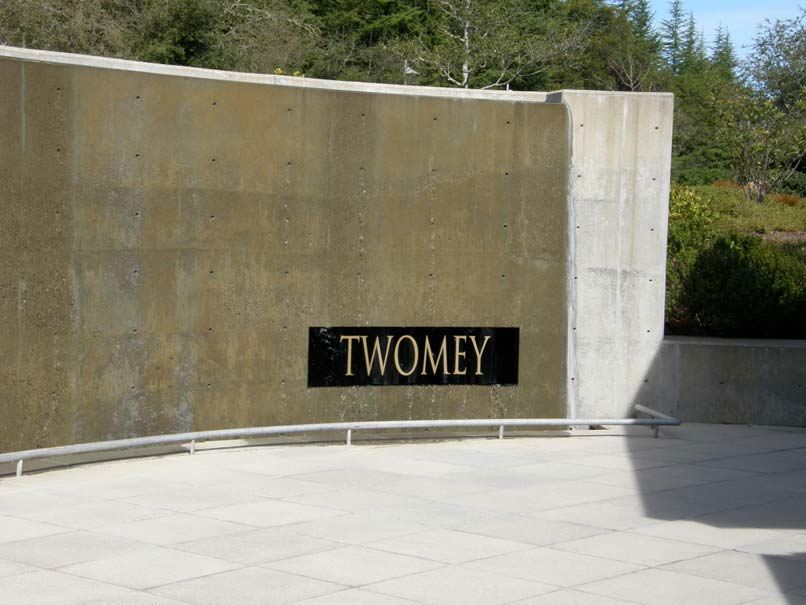
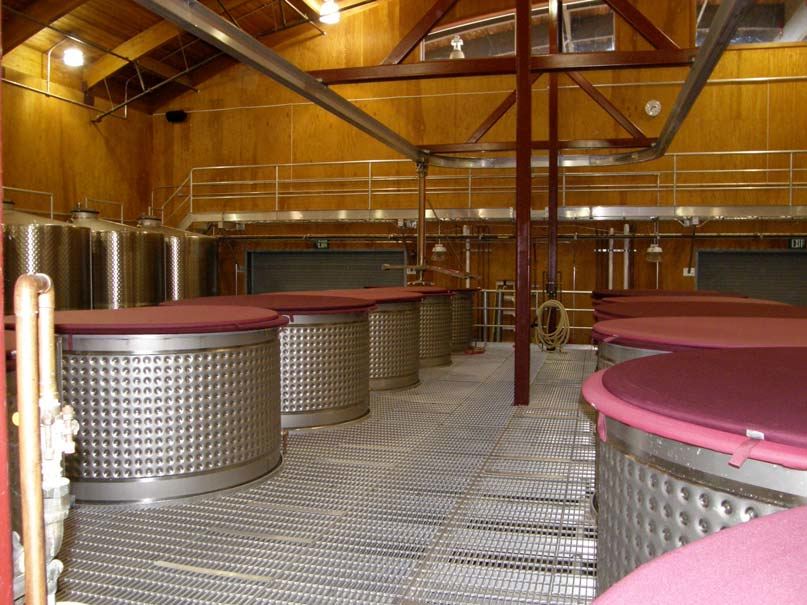
 The intent at Twomey Cellars is to produce blended appellation-designated Pinot Noirs, unless Twomey owns the vineyard and the vineyard is worthy of designation. Twomey acquired the Monument Tree Vineyard in Anderson Valley in 2010 and now forms the basis of its Anderson Valley Pinot Noir, with Savoy Vineyard and Ferrington Vineyard fruit playing lesser roles. In time, the Anderson Valley Pinot Noir may become a Monument Tree single vineyard Pinot Noir. The exception is the Central Coast appellation bottling which is sourced entirely from the Bien Nacido Vineyard. Since all the fruit comes from this renowned vineyard, beginning in 2009, the Central Coast Pinot Noir is designated Bien Nacido Vineyard. The Duncans were fortunate in that Lane Tanner decided to retire and they were able to acquire her own-rooted Block N rows, some of the first Pinot Noir plantings at Bien Nacido. The Bien Nacido Vineyard Pinot Noir includes Block N and two other blocks in this prestigious vineyard. The Sonoma Coast bottling is anchored by Gap’s Crown Vineyard located in the cool Petaluma Gap region of the Sonoma Coast, and the Russian River Valley Pinot Noir features primarily fruit from the estate WestPin Vineyard in the Middle Reach. The initial Pinot Noir winemaker at Twomey Cellars was Daniel Baron, but he now concentrates on the Twomey Merlot, but still directs winemaking at the Twomey’s Calistoga and Healdsburg wineries. Australian winemaker, Ben Cane, became the assistant winemaker for the Pinot Noir program at Twomey Cellars, and in 2008, assumed responsibility for the Sauvignon Blanc production as well. Cane has a B.S. in Organic Chemistry and Psychology from the University of Adelaide and a postgraduate diploma in enology from the same school. He has traveled and worked all over the world, including winemaking stints at Arcadian Wines in Santa Barbara County and Domaine Dujac in Morey-St.-Denis. Joe Davis, the owner of Arcadian Wines taught him the credo, “If we are going to make great wine, we have to drink great wine,” and that is exactly what they did. Cane holds true to this credo today. The style of Pinot Noir at Twomey Cellars is meant to be refined and food-friendly and has evolved over the last ten years. Night harvesting is followed by rigorous sorting. After a 7-day cold soak, indigenous yeast fermentations continue. Generally, 15% whole cluster fermentations are favored and the wines are raised for an average of 15 months sur lie in 35% to 50% new French oak barrels from ten different cooperages. I recently visited Twomey Cellars in Healdsburg and tasted with David Duncan and Daniel Baron. I re-tasted the four 2009 Twomey Cellars Pinot Noirs at home over a two day period. I was struck by the improvement in the wines compared to the last few vintages, which although solid, lacked charm and interest. The 2009 wines are another story and it is evident that Baron and Cane are dialing it in. The wines also benefited from a relatively uneventful growing season in California with moderate summer temperatures. The 2009 Twomey Cellars Pinot Noirs are currently a bit tight aromatically and benefit from time in the glass. All the wines were aromatically more expressive a day after opening and sitting in the cellar re-corked. They are crisp, juicy and refreshing with plenty of verve and moderately low alcohols with no disagreeable over ripe flavors (like many California Pinot Noirs today). All the wines have moderate reddish-purple color. Like Silver Oak Cabernet Sauvignon, the Twomey Pinot Noirs are made to be enjoyed shortly after release, but possess the structure and balance to age beautifully. I also tasted barrel samples of single vineyard lots from the promising 2010 vintage, giving me a peek at a future lineup of wines that will show even further refinement and complexity. David and Daniel are very excited about the 2010 vintage and rightfully so. There has been plenty of chatter in the wine press applauding restrained, lighter and more balanced Pinot Noirs, and the Twomey Cellars Pinot Noirs, which exemplify this style, are a clear example of why this genre of California Pinot Noir is becoming de rigeur for pinotaficionados. I, personally, applaud the trend. Clearly, there is a serious commitment at Twomey Cellars to produce Pinot Noirs to rival their lofty and iconic neighboring wineries on Westside Road. One example is an analytical berry tasting vocabulary they have developed to communicate the status of skin ripeness between field workers and winemakers. Skin, seed and pulp ripeness are critical determinations involved in picking decisions. The field worker can assess the maturity of the skins by chewing on the skins and then relaying their status by communicating with terms that are understood by those at the winery such as “leathery” (unripe) or “shredding” (easily fall apart). Similarly, seeds are evaluated (“turning brown,” for example, would indicate a degree of ripeness) and the pulp is characterized (“liquefied” would mean a certain stage of maturity). Another example is Silver Oak and Twomey’s commitment to avoiding cork taint. Corks are rigorously tested for TCA, and over the past few years, the incidence of cork taint has been reduced in the company’s wines from 2% to .5%, a small, but significant amount. Twomey Cellars Pinot Noirs and Merlot are priced at $50 and the Sauvignon Blanc at $25. The annual production at Twomey Cellars is 12,000 cases for all wines. The two tasting rooms, Twomey Calistoga and Twomey Healdsburg, are open daily. The wines are well distributed through finer retailers. Visit the website at www.twomeycellars.com for more information. Release date for the 2009 Twomey Cellars Pinot Noirs is April 30, 2011.
2009 Twomey Anderson Valley Pinot Noir 13.8% alc., pH 3.48, TA 0.62, 1,782 cases, $50. Monument Tree (Navarro), Savoy (Philo), and Ferrington (Boonville) vineyards representing different climates. Aged 14 months in 40% French oak barrels. · The nose opens slowly to reveal pleasing aromas of berry tart, baking spice, and toasty oak. On entry, there is a blast of very appealing cherry and raspberry fruit which clings to the lengthy finish. Subtle notes of cinnamon spice, vanilla and oak add interest. Discreet intensity, delicious tasting and noticeably crisp with supple tannins. A beautiful wine.
2009 Twomey Bien Nacido Vineyard Santa Maria Valley Pinot Noir 13.9% alc., pH 3.49, TA 0.57, 1,100 cases, $50. Sourced from blocks 1, 7 and 9, all organically farmed. Aged 15 months in 35% new French oak barrels. · Both fruity and savory scents highlighted by aromas of strawberries, raspberries, and fresh cut herbs, with accents of sandalwood and oak vanillin. Strikingly flavorful on the mid palate with generous amounts of layered red fruits flooding the mouth, yet light on its feet with an appealing elegance. Plenty of vim and vigor, smooth as silk, with a lively grip of acidity, and some impressive length on the pleasing finish that makes you want to take another sip. This wine is a love letter from heaven.
2009 Twomey Russian River Valley Pinot Noir 13.6% alc., pH 3.54, TA 0.54, 1,290 cases, $50. Sourced from WestPin Vineyard in the Middle Reach of the Russian River Valley complimented by a small amount of fruit from vineyards in Freestone and Forestville. Aged for 14 months in 50% new French oak barrels. · Brooding perfume of black cherries, ripe strawberries, baking spices, crusty bread and faint toasty oak. Perky and smooth on the palate, with moderately rich flavors of Bing cherry, cola, and oak vanillin. Crisp, with bright acidity on the refreshing and cherry-filled finish. Much better the following day from a previously opened and re-corked bottle. Very good.
2009 Twomey Sonoma Coast Pinot Noir 13.6% alc., pH 3.48, TA 0.63, 2,645 cases, $50. Sourced from Gap’s Crown Vineyard and La Cruz Vineyard, both located in the Petaluma Gap. Aged 14 months in 40% new French oak barrels. · Darker fruited and more intense on the nose with a complimentary note of spice, dried rose petals, and oak, opening slowly over time in the glass. The most generously flavored wine in the lineup with a core of juicy cherry pie filling and dark berry flavors accented by notes of dried herbs, vanilla and burnished oak, leaving the crisp flavor of cherry skins in its wake on the finish. A seamless wine with moderately firm tannins and well proportioned acidity. Very good (+).
Stemmler Wines That Would Make their Namesake ProudStemmler (Robert Stemmler Winery) is guided by proprietor Anne Moller-Racke, who also directs The Donum Estate. Robert Stemmler is a legendary winemaker in the Dry Creek Valley of Sonoma County. According to Charles Sullivan (A Companion to California Wine 1998) and the Stemmler website, Stemmler came to Northern California in 1960 from Germany, where he had made wine for nearly a decade. Stemmler worked at Charles Krug Winery and became winemaker at Simi while consulting for several other notable wineries including Inglenook, St. Clement and Raymond. He founded his own winery in the Dry Creek Valley in 1977 and found early success with Pinot Noir. His first Pinot Noir, sourced from a cool-climate Russian River Valley vineyard, received instant acclaim. One journalist called him the “Unwilling Prince of Pinot.” By 1986, his production was 10,000 cases. He mentored young Pinot Noir producers Davis Bynum and Gary Farrell. In 1989, he retired from winemaking after 35 years and the Rackes bought the label, keeping it alive as a tasting room brand within Buena Vista Winery. In 1996, the original Robert Stemmler winery facility was sold to Pezzi King. When Buena Vista was sold to Allied Domecq in 2001, the Racke family kept a vineyard that became The Donum Estate. The Ferguson Block Vineyard adjacent The Donum Estate and Nugent Vineyard in the Russian River Valley were added as estate vineyards and Robert Stemmler became Donum’s sister brand. Kenneth Juhasz crafts the wines for both The Donum Estate and the Robert Stemmler label. There is a firm commitment to sustainable winegrowing for both programs. The wines are available online at www.robertstemmlerwinery.com with some retail distribution.
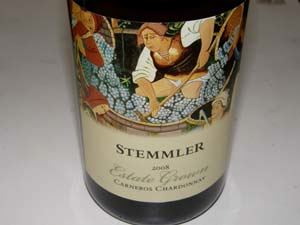 2008 Stemmler Carneros Chardonnay 14.1% alc., pH 3.28, TA 0.80, 875 cases, $34. From three sites on the Donum Estate, the oldest of which is the Ferguson Block planted in 1974 to the Wente selection. Also includes Dijon and Wierner selections. Partial MLF. Aged on its lees in 40% new French oak barrels. · Moderate straw color in the glass. Well-raised aromas of pear, white peach, apple, honey and cream soda. Brisk and juicy flavors of Asian pear, melon and baked apple which linger on the dry finish leaving behind a subtle aroma of oak. Solid, but not exceptional. Good (+).
2008 Stemmler Estate Grown Carneros Pinot Noir 14.4% alc., pH 3.66, TA 0.62, 4,409 cases, $36. From Demeter Certified vineyards. A potpourri of clones and selections including Dijon, Martini, Roederer, Calera, Hanzell and Swan representing every part of the estate. De-stemmed fruit, 4-6 day cold soak, extended maceration. Aged in 40% new French oak barrels. · Aromas of dark red Bing cherries and berries with a subtle hint of oak. A medium-weighted pleasing wine with tasty black cherry and plum flavors lingering on the finish which features some smoky oak in the background. Nicely crafted with soft tannins and ready drinkability. Good.
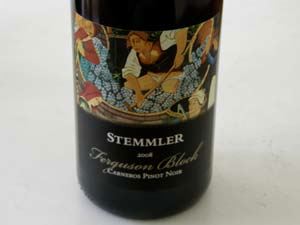 2008 Stemmler Ferguson Block Carneros Pinot Noir 14.4% alc., pH 3.57, TA 0.63, 159 cases, $44. Ferguson Block is less than a mile east of The Donum Estate. Planted in 1974 with a Martini selection on St. George rootstock in gravelly, loamy clay soils. Native fermentation, aged 16 months in 40% new French oak barrels. · Subdued, but pleasing aromas of cherries, strawberries and raspberries. Delicious essence of cherries and raspberries that saturate the mid palate and carry over to a Wow! finish that will send cherry lovers into ecstasy. Harmonious with supple tannins and faint oak adding support. Generous and forthcoming, offering immense pleasure now, but will age beautifully. Ferguson Block fruit is crazy good! Lovable.
2008 Pisoni Pisoni a Benchmark WineI have had my dalliances with Pisoni Vineyard Estate Pinot Noir through the years and wrestled with the muscular nature of some vintages, always enjoying the wines, but finding it a challenge to wrap my arms around some well-endowed and chewy wines. I have tasted the wines back to the 2003 vintage and was particularly struck by the 2006 and 2007 vintages. However, none of that parlance prepared me for the 2008 vintage, a wine of such exceptional breeding and refinement that I felt compelled to devote a feature to it alone. I have noticed through the years that certain Pinot Noirs reflect their maker or grower and the epitome of this is Gary Pisoni and Pisoni Vineyard Estate Pinot Noir. Those of you who have attended Pinot Noir events know Gary as a flamboyant, colorful and passionate voice of Pinot Noir. He is bigger than life, and his Pinots reflect that trait. With his long, curly hair, colorful Hawaiian shirts, and unbridled enthusiasm, he is one gregarious dude and a household name among Pinot circles.
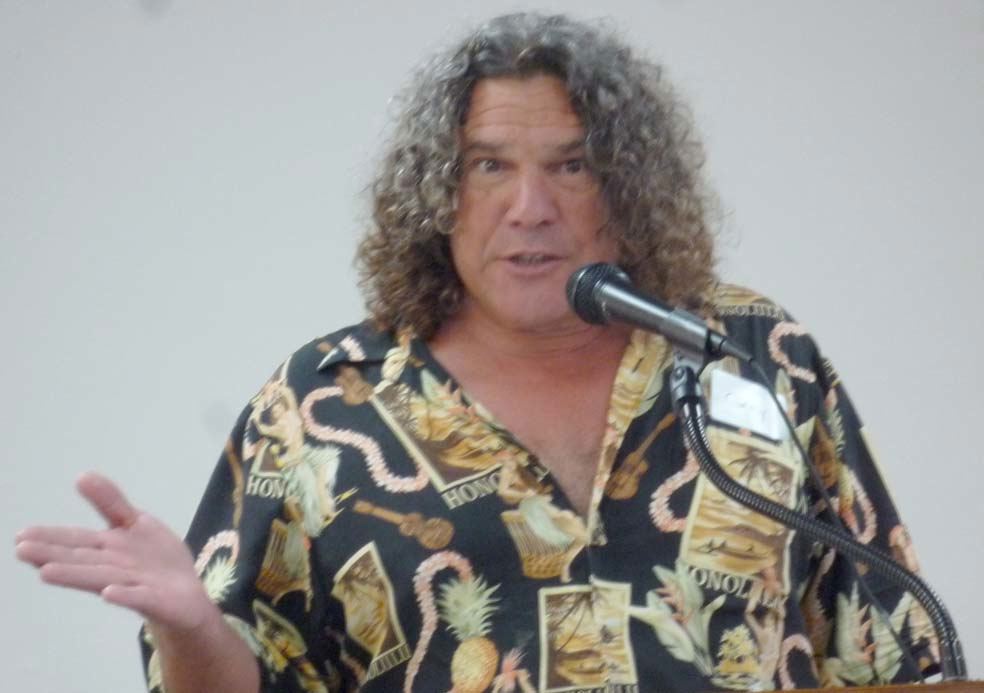 One of his sons, Jeff, who is the winemaker for Pisoni Vineyards, couldn’t be more opposite. He is charming in a quiet way, enthusiastic about his craft, but more intellectually directed and displaying his father’s lack of pretension.
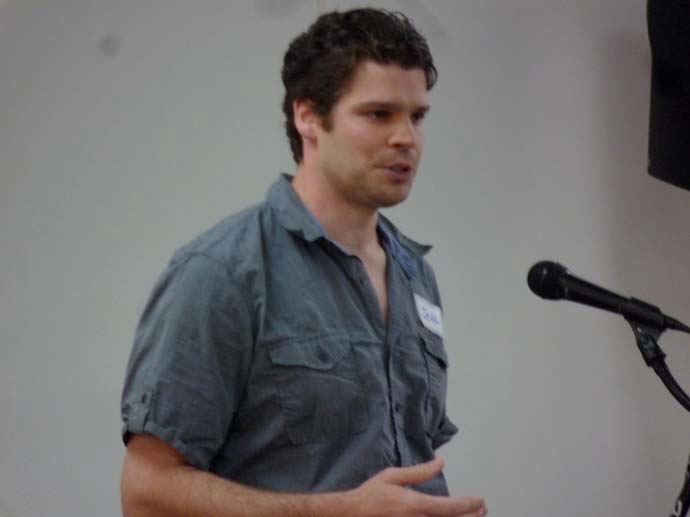 Winegrower Gary Pisoni comes from generations of farmers who tended row crops in the Salinas Valley long before he was born. When he graduated from college, he was eager to find a way into the wine business. When he told his father he wanted to plant grapevines on the family cattle ranch in the Santa Lucia Highlands, he was met with several objections. Gary countered to his father, “Have you ever been to a $250 lettuce tasting?” He father eventually relented and a legendary California vineyard was born in 1982. Gary planted his own-rooted vines in virgin soil. The vines are rumored to be suitcase cuttings from a very famous domaine in Vosne-Romanee, a source that is carefully guarded, and now a selection known as the Pisoni selection. Winemaker son Jeff and grape grower son Mark created the Pisoni label, releasing the first estate Pinot Noir in 1998. A second label, Lucia, debuted in 2000. Pisoni fruit quickly became highly prized in California and Pisoni Vineyard essentially put Santa Lucia Highlands on the map, becoming one of California’s true “grand cru” vineyards. Eleven artisan producers are members of the extended Pisoni family, all making Pisoni vineyard-designated Pinot Noir. A handshake with Jeff, Gary and Mark Pisoni seals the contract. The prestigious list includes Bernardus, Kosta Browne, Capiaux, Paul Lato, Peter Michael, Miura, Patz & Hall, ROAR, Siduri, Tantara and Testarossa. The Pisoni family retains 15 to 20 percent of the fruit for the Pisoni Estate wine (known by Pinot geeks as “Pisoni Pisoni”). The Pisoni Vineyard sits at 1,300 foot elevation. Gary’s close friend, Gary Franscioni, who met Gary Pisoni as a baby, likens Pisoni Vineyard to Disneyland, “A fantasy land come true with its Grand Cru vineyards, magical beauty, waterfalls and mystic cave. Mickey and Indiana Jones are jealous!” According to Jeff Pisoni, “Our 2008 Pinot Noir is one of our most aromatically complex wines of recent vintages. The nose is incredibly expressive and one is compelled to continue swirling the glass and smelling, as the wine continues to open up and evolve. The 2008 is a beautiful wine, very approachable in its youth, but one that will age gracefully for ten years or more.” For me, the 2008 Pisoni Vineyard Estate Pinot Noir is a vin de garde for the Santa Lucia Highlands, the culmination of years of devotion to the highest levels of winegrowing. Packed in a beautiful embossed wooden box, this wine is one I will treasure for years to come. Pisoni and Lucia wines are sold through a mailing list at www.pisonivineyards.com. The Lucia wines are distributed through retail channels, but the Pisoni Estate Pinot Noir is highly allocated to a faithful customer base. You may not be able to obtain the Pisoni Estate Pinot Noir, but there are eleven other producers of Pinot Noir from this vineyard whose wines are very stellar.
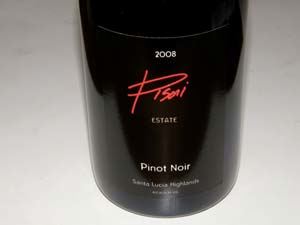 2008 Pisoni Estate Santa Lucia Highlands Pinot Noir 14.2% alc., $60. · Moderately dark reddish-purple color in the glass. Lovely aromas of dark plums, boysenberries, and sassafras with some nuanced floral and spice elements dancing in and out. Righteous juice that charms with its perfectly ripe, sappy dark fruit flavors and soft, silky mouth feel. Seamless with unbelievable persistence on the superbly intense finish. Descriptors cannot do this wine justice. One of the greatest California Pinot Noirs I have ever had the good fortune to drink.
Anderson Valley Pinot Noir: Redemption in 2009The 2008 vintage was a disaster in the Anderson Valley. Spring frost was followed by extreme heat spikes in summer and wildfires cast a smoky pall over the vineyards. The resulting yields were diminished and most of the wines were significantly smoke tainted, causing many Anderson Valley producers and wineries outside the region who source Anderson Valley grapes to declassify or fail to bottle the vintage. Fortunately, this one bad vintage was a brief misstep for this superb winegrowing region and the Pinot Noirs from the 2009 vintage are spectacular. I have only sampled a few, but every one has been vibrant with juicy fruit, lively acidity, crisp textures and precocious drinkability. I, for one, am thrilled by the quick redemption. Check out the lofty reviews of the four 2009 Anne Amie Annahala Vineyard Anderson Valley Pinot Noir, the 2009 Couloir Anderson Valley Pinot Noirs and the 2009 Twomey Cellars Anderson Valley Pinot Noir elsewhere in this issue, and the glowing reviews of Kutch Anderson Valley Pinot Noirs in the next issue. The annual Anderson Valley Pinot Noir Festival will be held May 19 (Technical Session) and 20 (Grand Tasting), 2011. For information and tickets visit avwines.com.
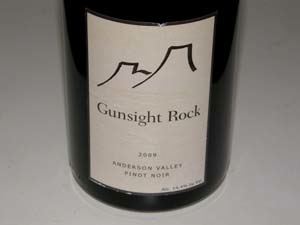 2009 Gunsight Rock Anderson Valley Pinot Noir 14.4% alc., $14.99. Not many details but apparently this wine is 100% Londer Vineyard fruit produced by Gunsight Rock Winery in Sebastopol. Sold at Bottle Barn in Santa Rosa in March for a ridiculously low price. Easily worth three times this amount. · Moderate reddish-purple color in the glass. Inviting aromas of black cherries, wooded forest and oak. Very tasty core of black cherry fruit on a medium frame with undertones of cola, baking spices, grilled fruit and oak. Well-crafted, soft in the mouth, and ready for enjoyment now. Like cherry pie day at cooking school: cherries, baking spices and very interesting results. A ridiculous value (<$200 a case including tax), and the best $15 Pinot I have ever drank. Very Good (+).
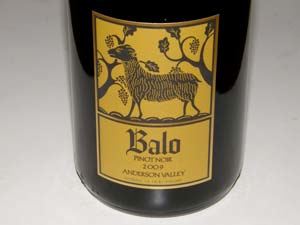 2009 Balo Anderson Valley Pinot Noir 14.1% alc., pH 3.65, VA 0.78, 275 cases, $39.95. Tim and Michele Mullins have been growing and selling grapes from their 8.25-acre Balo Vineyard in Philo since 2003. In 2009, they held back some of their best fruit and started their own label. Jason Drew, who has been buyer of Balo fruit, is the winemaker. Clones are 777, 828, 115, Martini and Pommard. Inaugural vintage. Aged 11 months in 30% new French oak barrels and bottled unfined and unfiltered. · Moderate ruby color in the glass. A well-mannered wine with brightly floral perfume overlying scents of pedigreed cherries and raspberries with a complimentary touch of spice and oak. Ripe black cherry essence with an undertone of cola and earth, displaying impressive persistence on the generous finish. Nicely integrated tannins and acidity create a seamless character. Very good.
 2009 Black Kite Kite’s Rest Anderson Valley Pinot Noir 14.8% alc., pH 3.60, VA 0.59, 1,000 cases, $42. The Green family owns the 12-acre Kite’s Rest Vineyard in Anderson Valley’s Deep End, farmed under the direction of noted viticulturist, Paul Ardzrooni. The winemaker is veteran Jeff Gaffner. A blend of the 3 4-acre blocks in the vineyard. · Moderate reddish-purple color in the glass. Very attractive scents of fresh cherries and red plums with more subtle accents of Spanish spices, dried rose petals and brewed coffee. A real lip-smacker with juicy spiced plum flavor and notes of tea leaves, clove and oak. The mid-palate is rich, round and mature with plenty of vim on the crisp, long finish. A very harmonious wine that will age beautifully and one to savor over a meal with good friends.
Sips of the Russian River Valley2009 Lutea Russian River Valley Pinot Noir 13.9% alc., $26. Organic grapes. 100% de-stemmed, cold soak, hand punch downs, gentle pressed, aged in French oak barrels, bottled unfined and unfiltered. · Dark color in the glass. Aromas of dried rose petals, brier and green garden. Dark red cherry and raspberry fruits with hints of cola, earth and green herbs. Some persistence on the fruit-filled finish that carries a grip of lively acidity. A green note runs through, seemingly from oak and/or under ripe fruit. Decent.
2009 August West Russian River Valley Pinot Noir 14.7% alc., $28. August West is a partnership between Gary Franscioni, Howard Graham and winemaker Ed Kurtzman. · Aromas of cherry tart, baking spices and a hint of oak. Moderately intense and concentrated with flavors of cherry pie filling, berry compote, cola and oak. Very smooth on the palate with soft tannins. Solid but not exciting. Good.
2009 Shane The Charm Russian River Valley Pinot Noir 14.1% alc., 100 cases, $32. · Deep, dark reddishpurple color in the glass. Slightly reduced initially, evolving to reveal shy aromas of dark fruits, cut flowers and smoky oak. Fat on the palate with a full load of plum and cassis flavor with a noticeable oak accent. Lacks acidity, seemingly a bit flabby with a slight bitterness on the finish. Decent.
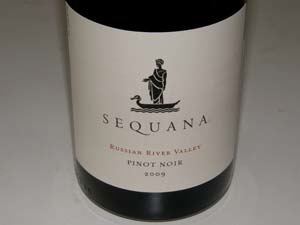 2009 Sequana Russian River Valley Pinot Noir 14.7% alc., pH 3.65, TA 0.56, 2,350 cases, $38. Grapes sourced from Green Valley of Russian River Valley. Aged sur lie in 40% new French oak barrels for 11 months. Winemaker is James MacPhail. · Medium reddish-purple color in the glass. Nicely perfumed with scents of fresh baked cherry pie, ripe strawberries and cut flowers. Elegantly composed with pleasing flavors of red cherries, cola and savory herbs. The texture is marked by silk and satin. Quintessential Russian River Valley Pinot. Very good.
 2008 Gary Farrell Russian River Valley Pinot Noir 14.2% alc., pH 3.47, TA 0.63, 4,332 cases, $42. 100% de-stemmed, 5-day cold soak, inoculation with Assmannshausen yeast, aged 8 months in a combination of 30% new, 27% 1- year old, 20% 2-year old, and 23% 3-year old French oak barrels. Winemaker Susan Reed. · Typical Russian River Valley perfume of Bing cherries, baking spices and cola. Slightly tart and lean flavors of well-spiced cherries and cranberries with oak providing support in the background and a note of minerality playing in the background. Soft, smooth and clean with brisk acidity. A restrained, food-friendly style that does not offer quite the fruit impact that one has come to expect from Russian River Valley appellation bottlings. Good.
 2007 Brogan Cellars Buena Tierra Vineyard Helio Doro Block Russian River Valley Pinot Noir 13.5% alc., $90. · Moderately light reddish-purple color in the glass. When first opened, the wine’s fruit was drowned out by oak. Within three days from a previously opened and re-corked bottle, the wine had dramatically transformed with integration of the oak and plenty of bright, nicely spiced black cherry and berry fruit at the forefront. I have tasted many vintages of this wine and this is a relatively light example, even feminine in style. The tannins are supple and the texture is silky adding to the appeal. Very good.
More Sips of Pinot Noir
2008 Benovia Sonoma Coast Pinot Noir 14.2% alc., 1,000 cases, $45. · Dark reddish-purple color in the glass. Deep aromas of black plums, black cherries, tar and mocha. Moderately rich and juicy flavors of cassis, black cherries and plum sauce with a subtle game and smoky note in the background. Nicely crafted in a fullon, fruit-driven style. Good.
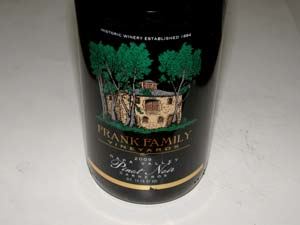 2009 Frank Family Vineyards Napa Valley Carneros Pinot Noir 14.5% alc., $35. Frank Family Vineyards was founded in 1992 and owns over 200 acres of vineyards in the Napa Valley. This wine is sourced from the Frank Family’s 138- acre Lewis Vineyard, located in the heart of Napa Carneros, near the shores of San Pablo Bay, and three other vineyards in the Carneros region. The winemaker is Todd Graff. Aged 12 months in 35% new and 65% 1-year old and 2-year old French oak barrels. · Moderate reddish-purple hue in the glass. Very shy nose offering demure dark fruit aromas with a combination of brier, pine and oak. Lovely core of black cherries and blackberries with the oak and pine showing up again on the palate. An earthy meatiness is evident as well that reflects the clay loam soils typical of Carneros Pinot. Light to medium in weight, the fruit flavors are flat-out delicious and the dusty tannins and bright acidity add to the appeal. Definitely worth a look from a producer not known for Pinot Noir. Very good.
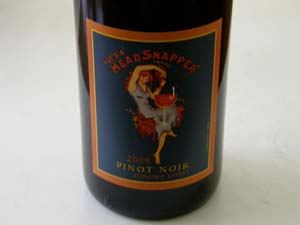 2009 It’s A Headsnapper Sonoma Coast Pinot Noir 14.2% alc., $12.79. A real surprise from Headsnapper Wines in Sonoma. Nicely packaged and an attention grabber on the market shelf. Offered at Vons Market that virtue of 30% off plus 10% off for a purchase of 6 bottles, this wine was selling for $8.95. An unbelievable value and a headsnapper for sure. · Pleasing aromas of black cherries and dusty oak. Moderately light, slightly confected flavors of cherries and cola with brown spice, smoke and char in the background from oak. Very soft in the mouth with a clean finish. Certainly not the sophistication of other wines reviewed in this section, but a delightful back porch pounder. The slight confection may turn off some Pinot connoisseurs. Good.
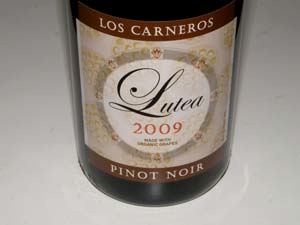 2009 Lutea Los Carneros Pinot Noir 13.9% alc., $26. Organic grapes. · Moderately dark reddish-color in the glass. Enticing aromas of black cherry cobbler with vanilla ice cream and a chocolate malt. Delicious fruit core displaying bright flavors of black cherries and black raspberries with hints of dark chocolate. Nicely composed and balanced with well-mannered tannins and amazing persistence on the fruit-driven finish. Very good.
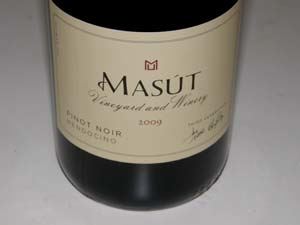 2009 Masút Vineyard & Winery Mendocino Pinot Noir 14.2% alc., pH 3.54, TA 0.06, $40. A discovery this year at the World of Pinot Noir. Brothers Ben and Jake Fetzer produce an estate-grown Pinot Noir dedicated to the legacy of their father, Bobby Fetzer, a well-known and respected winegrower. The Masút Vineyard is certified organic and is located in the Redwood Valley at the headwaters of the Russian River. Clones are 777, 115 and 113. Aged in 55% new French oak barrels. · This is a wine of character with black cherry as its central theme. The fruit is fresh and bright, accented by a savory herb flavor, and displaying some oak-driven spice and mocha notes. Admirable finesse, with a long, juicy finish. Much better the next day from a previously opened and recorked bottle. Will benefit from more time in the bottle to further integrate the oak. Very good.
Craig and Cathy Handley farm a small vineyard planted to Pinot Noir and Chardonnay surrounded by coastal redwoods within Pleasant Valley in Aptos, California, at the southern end of the Santa Cruz Mountains appellation. The vineyard has significant maritime influence from nearby Monterey Bay. The vines are carefully nurtured by hand. An estate Pinot Noir and two Pinot Noirs from nearby Lester Family Vineyards are produced. These are wonderful people who aim high.
2007 Pleasant Valley Vineyards Dylan David Family Estate Reserve Santa Cruz Mountains Pinot Noir 14.65% alc., pH 3.50, TA .542, $120 (library wine). Dijon clones 113, 114, 115. 100% de-stemmed. Aged 19 months in 100% Sequin Moreau Grand Cru French oak barrels. Unfined and unfiltered. · Moderately deep reddish-purple color in the glass. Aromas of dark berries, black plums, old book, root beer and oak vanillin and spice. Very ripe plum and black cherry flavors with cola and oak as contributors. Juicy and silky, this wine has a copious charge of alcohol-driven sweet fruit and some finishing heat showing up on the finish as the wine warms in the glass. Decent.
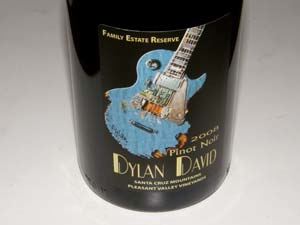 2008 Pleasant Valley Vineyards Dylan David Family Estate Reserve Santa Cruz Mountains Pinot Noir 14.0% alc., pH 3.41, TA .586, $95. From an estate vineyard planted in 1996 to Dijon clones 113, 114 and 115. Fermented whole berry after de-stemming. Aged 19 months in 100% new Sequin Moreau Grand Cru French oak barrels (medium toast and toasted heads). Unfined and unfiltered. · Moderate reddish-purple color in the glass. Shy, but pleasing aromas of crushed berries, rose petals and white pepper. Well-endowed with blackberry and plum flavors, restrained tannins, and leaving an impression on the generously fruited finish. The oak never intrudes. Nicely crafted, but lacks nuance which may come with more time in the bottle. Good (+).
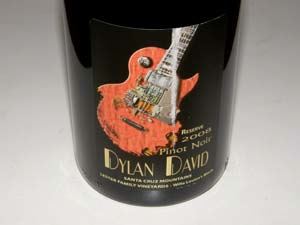 15.0% alc., pH 3.50, $60. Aged 15 months in 50% new and 50% 1-year old Sequin Moreau French oak barrels. Dijon 667 clone. Unfined and unfiltered. · Moderate reddishpurple color in the glass. An expressive nose offering scents of very ripe fruit, spice, root beer and old oak. The black cherry and berry fruit is over ripe with a roasted quality. Rich layers of fruit linger on the finish which is slightly hot. The flavors and aromas dissipate with time in the glass, leaving plenty of fruit but no refinement. Decent.
15.5% alc., pH 3.59, $48. Aged 12 months in 50% new and 50% 1-year old Sequin Moreau French oak barrels. · Moderately deep reddish-purple color in the glass. Ripe, raisiny, old oak cask aromas. Very ripe fruited flavors with a raisin note and plenty of root beer, dark caramel and mocha flavors from oak. Well-crafted, but the slightly cooked fruit and prominent oak disappoint. Decent.
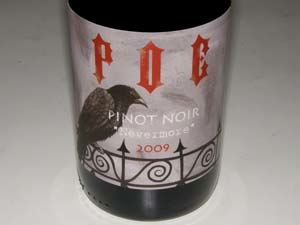 2009 Poe “Nevermore” Corda Vineyards Marin County Pinot Noir 14.1% alc, 150 cases, $38. Winemaker Jonathan Keys worked in the cellar at Sine Qua Non and is now working with Thomas Rivers Brown at Outpost. This is his inaugural release. Back label says, “Ravens that dwell in Marin County inspired him to use the name after the poet who wrote, “The Raven,” in 1845. Very cool label. · This wine is definitely in the Sine Qua Non mode. Deeply colored in the glass. Hi-tone and intensely fruity nose displaying aromas of plum reduction sauce, black raspberries and vanilla wafer. Dense and concentrated flavors of fresh plums and black currants with a subtle note of oak vanillin. The silky smooth texture and fruitiness have seductive charm. The finish is clean and long but leaves a hint of heat in its wake. Syrah in drag. Not my favored style of Pinot Noir, but the saucy fruit will definitely have fans. Good.
2008 Portola Vineyards Santa Clara Valley Pinot Noir 14.8% alc., pH 3.71, TA 0.50, 130 cases, $38. Sourced from the 2-acre Los Trancos Creek Vineyard located in the foothills of the Santa Cruz Mountains. The vineyard was certified organic by CCOF in 2010. Aged 14 months in 80% new French oak barrels. · Medium ruby color in the glass. Charming cherry and berry fruit on the nose with a noticeable oak contribution showing up as aromas of brioche, toast and caramel. Demure cherry and berry flavors, silky textured, and easy to drink, improving in appeal over time in the glass and offering some length on the warm finish. A bit heavyhanded on the oak which overwhelms the level of fruit intensity. Some of the oak should integrate further with more time in the bottle, but the wine will always have an oaky presence. Decent (+).
Burn Cottage VineyardI have known about this new project in Central Otago, New Zealand, since noted winemaker Ted Lemon (Littorai) mentioned his involvement to me a while back. This new winery has now released its inaugural vintage. Burn Cottage is a 68-acre estate near the town of Cromwell in Central Otago close to Felton Road. 27.5 acres have been planted to vines beginning in 2002. The property is an integrated farm, not just a wine estate, with chickens, sheep, cows and beehives, as well as a number of other agricultural crops on the property. All farming is by biodynamic methods. Burn Cottage was the first vineyard in Central Otago to be developed from bare land using only biodynamic farming. Burn Cottage is owned by the Sauvage family, Americans hailing from Kansas. Marquis and Dianne Sauvage successfully operated a wine distribution firm in four states in the United States but were taken by New Zealand and its wines during a visit in 2001. The property’s vines began setting fruit in 2006, but no wine was made until 2008, an experimental lot sold under a second label. Ted Lemon was asked to visit Burn Cottage and a partnership soon followed. He has been with Burn Cottage since its inception and oversees all aspects of the winery and vineyards. The onsite general manager is Jared Connolly. Noted winemaker Claire Mulholland of Martinborough Vineyards was hired as General Manager and Associate Winemaker. Currently the Burn Cottage Pinot Noir is crafted at a modest winery in Cromwell and includes the first grape sorting table ever installed at a Central Otago winery. Long term, the owners plan to build a winery on their own property. The inaugural release is from the 2009 vintage. The Sauvages note in their initial offering newsletter, “We promise always to produce honest, pure wines with as little human interference as possible, wines which will speak of the beautiful property on which they were born.
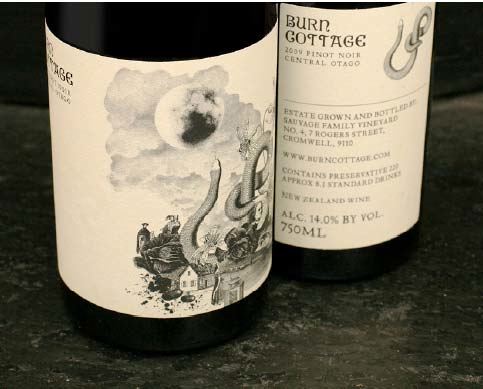 The winery website is www.burncottage.com. There are multiple importers in the United States (the list is on the website). Read the interesting story behind the label on the website. I have not tasted the wine so I am eager to hear from anyone about their experience.
Affairs of the Vine Pinot Summit ResultsThe 9th Annual Pinot Noir Summit was held in San Francisco on February 26, 2011. 64 Pinot Noirs were chosen by a diverse tasting panel to be in the final tasting offered in a blind format to consumer attendees. The favorite wines of the consumers and judges were announced according to gender at the conclusion of the public tasting. For details and information of the Pinot Noir Summit and other events organized by the “Wine Evangelist,” Barbara Drady, visit www.affairsofthevine.com.
 Men Consumers
Second Place: 2008 McIntyre Vineyards Hahn Estate Santa Lucia Highlands Pinot Noir $36 Third Place: 2007 DaVine Cellars Santa Cruz Mountains Pinot Noir $28 Women Consumers
Second Place: 2009 Leveroni Vineyards Seven Oaks Vineyard Sonoma Valley Pinot Noir $19.50 Third Place: 2008 Portalupi Russell Family Ranch Paso Robles Pinot Noir $48 Men Judges
Second Place: 2007 Lucienne Lone Oak Vineyard Santa Lucia Highlands Pinot Noir $45 Third Place (tie): 2009 Expression 39 Annahla Vineyard Anderson Valley Pinot Noir $48 and 2008 Woodworth Vineyards Estate Temecula Valley Pinot Noir $33 Women Judges
Second Place: 2009 Coghlan Vineyard Sta. Rita Hills Pinot Noir $47 Third Place: 2008 Fess Parker Santa Barbara County Pinot Noir $25 A number of my favorite wines were also in the finals including 2008 Alma Rosa Winery & Vineyards La Encantada Vineyard Sta. Rita Hills Pinot Noir ($34), 2007 Athair Russian River Valley Pinot Noir ($26), 2008 Asuncion Ridge Vineyards San Luis Obispo County Pinot Noir ($38), 2009 Balletto Vineyards Estate Russian River Valley ($24), 2008 C. Donatiello Floodgate Vineyard Block 15 Russian River Valley Pinot Noir ($48), 2007 Canihan Family Cellars Estate Sonoma Valley Pinot Noir ($39), 2008 Costa de Oro Dijon Selection Gold Coast Vineyard Santa Maria Valley Pinot Noir ($60), 2008 Davis Family Vineyards Horseshoe Bend Russian River Valley Pinot Noir ($42), 2007 Mahoney Vineyards Mahoney Ranch Carneros Pinot Noir ($32), 2008 Mueller Russian River Valley Pinot Noir ($29), 2007 Tondre Tondre Grapefield Santa Lucia Highlands Pinot Noir ($40), and 2008 Vine Hill Santa Cruz Mountains Pinot Noir ($30).
Report From the Front Lines: 2011 Pinot Paradise
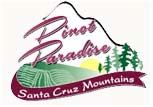 I attended the recent Pinot Paradise event sponsored by the Santa Cruz Mountains Winegrowers. The 7th Annual celebration of Pinot Noir in the Santa Cruz Mountains consisted of three parts held over two days: Saturday Pathway to Pinot Paradise open houses at participating wineries, a Sunday morning Technical Session, and a Sunday afternoon walk around tasting billed as Grand Cruz, the latter two at Villa Ragusa in Cambell. This year’s Technical Session featured Dr. Roger Boulton, Professor and Chair of the Enology Department of Viticulture and Enology, Agriculture and Environmental Sciences at University of California at Davis and Greg La Follette, an international vineyard and winemaking consultant and owner of La Follette Winery. The subject of the session was “The Santa Cruz Mountains Acid Test,” a discussion of the origin and influence of natural acidity in wine from a winemaking and viticultural perspective. Dr. Boulton’s main comments are summarized here. The acidity in wine consists primarily of tartaric acid with lesser amounts of malic acid, lactic acid (after MLF), and traces of citric acid and succinic acid (during fermentation). The pH of a wine is a measure of how acidic or alkaline a solution is and relates to the concentration of hydrogen ions in solution: the number is inversely related to acidity with a low pH an indicator of high acidity. This is a critical measurement during winemaking and ideally should be below 3.60 for sulfur dioxide to be effective during the winemaking process. A higher pH will reduce the effectiveness of sulfur dioxide and increase the chance of Brettanomyces growth. Titratable acidity (TA) produces the acid sensation in the mouth and is most critical for mouth feel. pH and TA values do not run parallel. A wine can have a high pH and low TA or vice versa. Greg La Follette, respectfully called “Mr. Science of Pinot Noir,” threw out a number of pearls. He emphasized the importance of the timing of vine leaf pulling and where on the vine the leaves are discarded. La Follette said that the single most important decision in a vineyard is when to begin irrigation. ideally, a little water deficit is achieved before irrigation. Proper irrigation management leads to earlier physiologic ripening, better tannin ripeness, better color and improved acid balance. That said, don't want to overstress the vines. He is an advocate of cane pruning and arching the vine cane. Chewing on seeds and stalks is critical to him for evaluating grape maturity. He also checks the aromatics of the stems and if he finds Christmas spice, he adds stems back underneath the de-stemmed fruit in the fermenter. In the winery, La Follette is a fan of halved milk tanks because the cap is very thin and punch downs are much easier. He is a firm believer in barrel aging Chardonnay and Pinot Noir but he is not a fan of 100% new oak, arguing that the only thing all that oak does is impart oak flavor to the wine. La Follette opposes fining wines as it can strip a wine's body and aromas and there are huge potential risks. The decision to fine will depend on the vineyard. Final message: there is no substitute for knowing your vineyard. Several Santa Cruz Mountains Pinot Noirs were presented by their winemakers and some brief impressions follow.
Thomas Fogarty Winery Nathan Kandler who has been the Associate Winemaker at Thomas Fogarty since 2004 presented the wines from this winery located in the Skyline subdivision of the Santa Cruz Mountains. The estate vines are now 30 years old. 2008 Thomas Fogarty Windy Hill Santa Cruz Mountains Pinot Noir pH 3.8, TA 0.50. Located at just under 2000 feet above sea level with a windy exposure. Cane pruned, 8’ x10’ spacing, 2.5 acres, Martini and Bruce selections. 33% whole cluster, native yeast fermentation, aged in 50% new French oak, 18 months elevage. Darkly fruited with generous plum flavor finishing long. 2008 Thomas Fogarty Rapley Trail Santa Cruz Mountains Pinot Noir pH 3.7, TA 0.45. Located at 1,650 feet above sea level, 200 yards from Windy Hill. Martini clone on AXR1. Picked earlier than Windy Hill. Striking, very expressive aromatics, softer tannins, less earthy and concentrated, more appealing for me.
Owner and winemaker Dave Moulton presented his wines. The estate vineyard was planted in 1990 and 1991 and the winery was bonded in 1992. 3 acres of Pinot Noir, 115, 667 and 777. Dry-farmed since 2000. Located at 1,600 feet with full sun exposure. Cordon trained, yields of 2 tons per acre. Pinot Noirs are inoculated for primary and secondary fermentations and aged 18 months in 60% new French oak barrels. 2007 Burrell School Vineyards Estate Santa Cruz Mountains Pinot Noir 14.1% alc., pH 3.49, TA 0.68. Aromatic with a floral bent. Smoky and earthy with fruit flavors of plums and cassis. Smoothly textured with a generous fruit-endowed finish. 2008 Burrell School Vineyards Estate Santa Cruz Mountains Pinot Noir 14.3% alc., pH 3.52, TA 0.67. Flavors of plums and black grapes, well-oaked with substantial tannins and bright acidity. Needs time.
Owner and winemaker Jeff Emery has been making wine since 1979 and spent 25 years working with Ken Burnap, the founder of Santa Cruz Mountain Vineyard, who arrived in the Santa Cruz Mountains in 1968. Jeff’s first vintage with Burnap was 1975. Jeff’s goal after Ken retired was to improve the approachability of the wines but retain their age ability, something Burnap’s older wines did not have. Jeff has a library of wines to call on and at this year’s Pinot Paradise, was releasing the 2001 Estate Reserve. He emphasized the importance of holding wines back so you can learn about the vineyard source and the age ability of the resulting wines. The estate vineyard is dry farmed. Native fermentations are used with low new oak elevage. No acid additions are necessary. 2001 Santa Cruz Mountain Vineyard Estate Reserve Santa Cruz Mountains Pinot Noir12.5% alc., pH 3.20, TA 0.64. “Burgundian” styled. Rustic, slightly tart fruit flavors with dry leaf accent. Substantial tannin and zingy acidity. Needs even more time. 2004 Santa Cruz Mountain Vineyard Reserve Santa Cruz Mountains Pinot Noir 14.2% alc., pH 3.48. Branciforte and Bailey vineyards combined with Estate fruit. Dijon clones. Aged in French and Hungarian oak. Much more approachable displaying upfront fruit and a more flashy style. Aromas of mixed Pinot fruits, tobacco and leaf. Medium-weight core of red and black fruits with restrained tannins.
Owner and winemaker Jim Schultze planted his estate vineyard in 1996 and 1997 in Corralitos. He know farms two other estate vineyards for a total of 26 acres of Pinot Noir. The home vineyard is 14 acres of Pinot Noir and 1 acre of Chardonnay. Jim learned his winemaking in Australia as well as Burgundy. He usually uses 30% whole cluster but has pushed the amount in recent years to even 100%. Fermentations in 1-ton bins are very slow because the winery site is quite cold, lasting 30 to 40, even 50 days. 2008 Windy Oaks Henry’s Block Santa Cruz Mountains Pinot Noir 14.3% alc., VA 0.67. 8-day cold soak, 50% native fermentation, 34-39 day fermentation, aged 22 months in 50% new French oak barrels, unfined and unfiltered. Wädenswil clone. Delicious array of red fruits with an appealing touch of spice and anise. Beautifully balanced. A great Pinot is rarely seen from this clone as a stand-alone in California, but it works in this terroir. Jim feels it is the most terroir-driven wine in his lineup.
It is not easy getting your arms around the Santa Cruz Mountains region, for it spreads over 380,000 acres in three counties: Santa Cruz County to the West, Santa Clara County to the East, and San Mateo County to the North. It is a scenic, but lengthy, two hour drive from the northern end at Half Moon Bay to the southern end at Mount Madonna north of Gilroy. The wineries are tucked into nooks and crannies and well hidden in the mountainous terrain, often at the end of one lane, circuitous roads. County regulations prevent prohibit signage on major highways directing you to the wineries, GPS signals are unreliable in many areas, and cell phones can be worthless. The challenges of navigating to the wineries is offset by the beautiful landscape and lack of traffic. The Santa Cruz Mountains is one of the few remaining California wine regions where you will never see a limousine and tasting room staffs are very appreciative of your efforts to seek them out. It is this relative isolation that has kept the Santa Cruz Mountains from becoming a popular wine tourist region, but the locals are fine with that. The region retains its eccentric charm and the Bohemian folks who favor the other crop you can smoke rather than the one you can drink may disdain visitors, but the wine populace is more than welcoming. The Santa Cruz Mountains Viticulural Appellation was federally approved in 1981 and was one of the first appellations to be defined by geophysical, altitudinal and climatic factors. The eastern and western boundaries are defined by elevation, including mountainous land above 400 feet on the western side, and from 400 to 800 feet on the eastern side. The squiggly outline of the Santa Cruz Mountains appellation reflects the fog line that surrounds the mountains.
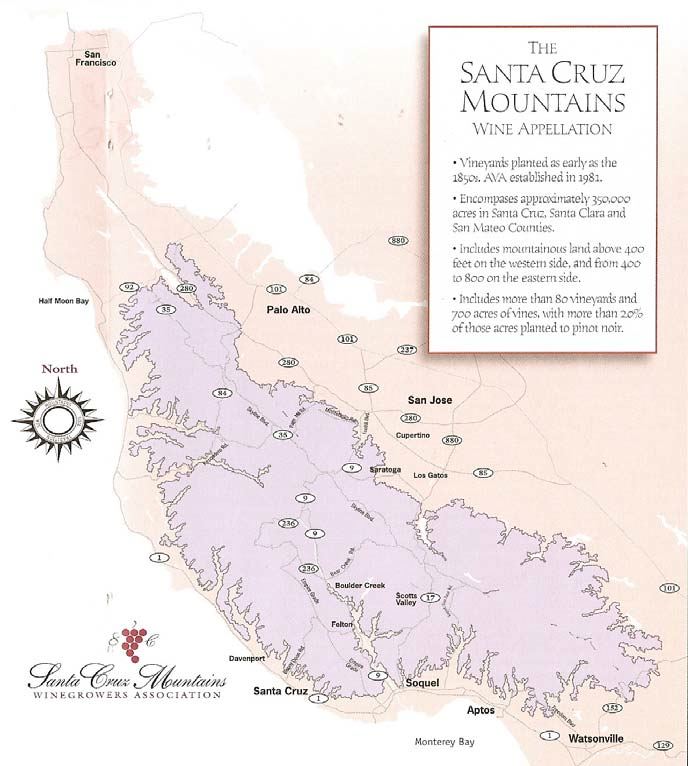 There are under 1,000 acres of Pinot Noir in the appellation, most of it composed of 1 to 20-acre plantings on moderately steep hillsides on the western mountain ridges above Monterey Bay and the fog line. Located at elevations of 400 to 2,600 feet, most vineyards are exposed to warm days, cool nights, morning coastal fog, and soft marine breezes in the afternoons. There are at least 90 wineries in the Santa Cruz Mount appellation, over half of which produce Pinot Noir. Because of the limited acreage, some Santa Cruz Mountain wineries source grapes from outside the appellation, but it is the Santa Cruz Mountain fruit that is most prized and produces the distinctive mountain-grown Pinot Noirs that have made the region famous. The Pinot Noir vineyards in the Santa Cruz Mountains have been grouped into six sub-regions and include Skyline, Summit Road, Coastal Foothills, Ben Lomond Mountains, Saratoga/Los Gatos, and Corralitos/ Pleasant Valley. Each of the sub-regions have different climatic influences and extensive tastings have shown each sub-region to have distinctive aromatic and flavor profiles. The quality of the Pinot Noir grapes grown in the Santa Cruz Mountains appellation is unquestioned, but it has taken the efforts of experienced vineyard consultants such as Prudy Foxx and Greg Stokes to bring viticultural practices into the modern age. Irrigation water is very limited or nonexistent, birds, deer and gophers are ever present, top soil is poor in many sites, skilled labor is hard to find, and disease pressure, particularly downy mildew, powdery mildew and botrytis is a constant threat. Santa Cruz Mountains Pinot Noir is known for two highly desirable features: acidity and minerality. The wines often offer lovely aromatics, moderately lush red and dark fruit flavors, good tannic structure, and impressive age ability. Despite the potential for greatness, the quality of Pinot Noir produced in the Santa Cruz Mountains remains variable and is frankly disappointing in some cases. Unfortunately some of the best and most admired producers in the region do not participate in Pinot Paradise for various reasons so the event does not offer a complete picture of the region’s bounty. This year, Clos de Tech, David Bruce, McHenry, Rhys Vineyards, Salamandre, Testarrosa, Trout Gulch Vineyards and Varner were among those absent. This year, 44 wineries did participate and though I was not able to taste every winery’s offerings, I managed to sample a majority, and presented here are wineries and wines that particularly impressed me.
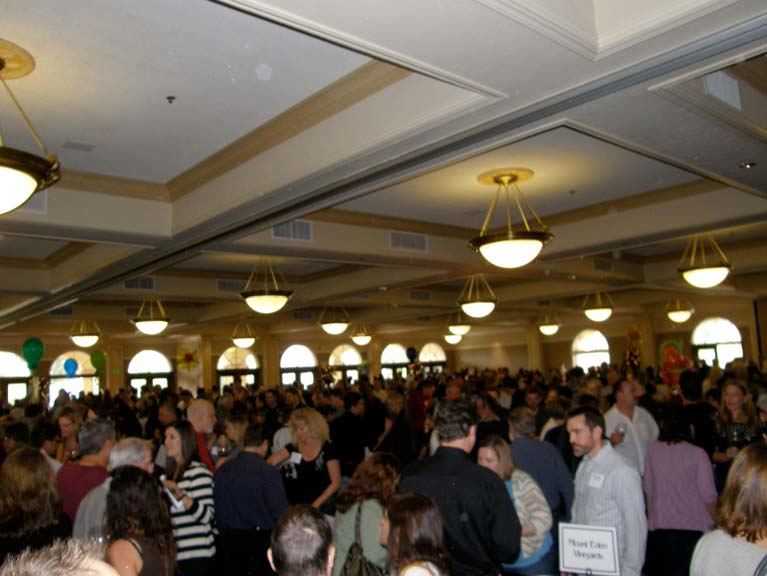 Alfaro Family Vineyards: 2008 “A” Estate Pinot Noir ($25) and 2007 Lindsay Page Vineyard Estate ($40). Richard Alfaro has upped his whole cluster additions and added whole berry fermentations beginning in 2008. Located in the Corralitos/Pleasant Valley sub-region. www.alfarowine.com. Big Basin Vineyards: 2008 Woodruff Family Vineyard (only 70 cases). A charming wine with appealing demure red cherry flavors. Three single-vineyard Santa Cruz Mountains Pinot Noirs are sourced from vineyards in the cool Corralitos region and fermented whole berry and whole cluster with native yeasts. A very promising new producer. www.bigbasinvineyards.com. Tasting room in Saratoga. Black Ridge Vineyards: 2008 Estate Pinot Noir ($39) showed very pretty fruit with bright acidity and complimentary smoky oak. A very appealing wine that has won considerable well-deserved praise in the wine press. Tasting room in Los Gatos open the third weekend of each month. www.blackridgevineyards.com. Clos Tita Winery: Now in its fifteenth year producing small lots of estate and sourced Santa Cruz Mountains Pinot Noir, owner and winemaker David Estrada produces terroir-driven and age worthy wines that really are a regional treasure. The 2007 Santa Cruz Mountains Cuvee consisting of 85% Branciforte Vineyard fruit (nonirrigated Dijon vines) was outstanding with very forward aromas and flavors. The 2007 Estate Pinot Noir, made from five non-irrigated clones planted in a 1-acre estate vineyard, is more focused and serious, displaying an array of dark fruits wrapped in well-honed tannins and showing impressive earthy character. The wines are not rushed to the marketplace and are hard to find as they are crafted in tiny lots (only 75-100 cases of Estate Pinot Noir annually), but worth the search. www.clos-tita.com. Hallcrest Vineyards: Owner and winemaker John Schumacher crafts a number of Santa Cruz Mountains Pinot Noirs from sources scattered throughout the appellation. 2006 Vista Del Mare Vineyard Pinot Noir offers lovely aromatics, moderately discrete black plum and blackberry flavors, with a well managed tannic backbone and bright acidity. Tasting room open daily. www.hallcrestvineyards.com. Heart O’ The Mountain: This historic estate was first established in 1881 and was once owned by the famous director Alfred Hitchcock. This producer offers small lots of estate grown Pinot Noir crafted in a well-oaked, concentrated, voluptuous style. One of the most popular booths at the tasting. The 2007 Estate Pinot Noir is darkly colored, packed and stacked with dark red and black fruits, assuming a spicy and oaky underpinning. The 2008 Estate Pinot Noir is still unevolved with plenty of tannin and oak on the mid palate and at 15.2% alcohol, has plenty of sweetness. For those who like their Pinots big. Kings Mountain Vineyards A real discovery for me as I had never tasted the wines from this tiny winery located in the town of Woodside close to my alma mater. The vineyard was planted in 1992 on a private estate dating to the late 1800s and is just over 1 acre in size. The 2002 Estate Pinot Noir was alive and fresh with plenty of juicy fruit, accents of savory herbs and subtle oak and admirable balance. Still available from the winery. The 2007 Estate Pinot Noir was similarly styled and flavored, a bit crisper and brighter. www.kingsmountainvineyards.com. Not open to the public. Mount Eden Vineyards: A historic winery that has had noted winemaker Jeffrey Patterson at the helm for many years. The Pinot Noirs and Chardonnays are consistently stunning examples of Santa Cruz Mountains terroir, always well-mannered, well-composed, and beautifully balanced for long-term aging. Mount Eden’s lineage of estate bottled Chardonnay and Pinot Noir is the longest in California. I have tasted the 2008 Estate Pinot Noir many times, given it my highest accolades in my reviews, and snatched two signed magnums that were offered at the event’s auction. A surprise was the 2009 Domaine Eden Pinot Noir sourced from the old Cinnabar Winery vineyard now owned by Mount Eden. A more forward, early drinking wine ($35), it shows good breeding, very tasty raspberry fruit and welcoming finesse. Unreleased. www.mounteden.com. Tastings in San Francisco at Press Club, none at the winery. Nicholson Vineyards & Winery: Established in 2004 and located in Pleasant Valley. 1,200 cases of Pinot Noir and Chardonnay and a few other varietals are produced annually. The 2008 Estate Brooks’ Block (100 cases, $30) and 2008 Estate Reserve (50 cases, $39) were both poured. The wines are built for aging, but display enough fruit and structure to impress now. The Reserve is the most unevolved with oak currently trumping the fruit. www.nicholsonvineyards.com. Odonata Wines: A boutique family winery making small lots of multiple varietals with an emphasis on Rhone wines. Owner and winemaker Dennis Hoey is the production manager for Santa Cruz Mountain Vineyard. The 2009 Domani Vineyard Pinot Noir (70 cases) is a distinctive and thoroughly enjoyable Pinot with hi-tone aromatics and plenty of sweet, juicy fruit. Dennis was also pouring a 2009 Top Black Vineyard Pinot Noir (20 cases) from a vineyard located in the Vine Hill sub-region that was impressive as well. www.odonatawines.com. Pleasant Valley Vineyards: see reviews under “More Sips of Pinot Noir” in this issue. Silver Mountain Vineyards: Pinot Noirs crafted by the team of owner and winemaker Jerold O’Brien and winemaker Tony Craig. The 2007 Muns Vineyard Pinot Noir has been reviewed and tasted on several occasions and is a recommended example of a mountain Pinot Noir imbued with bright acidity and minerality. www.silvermtn.com. There are gorgeous views from this estate that is open by appointment. Sonnet Wine Cellars: Both the 2007 and 2008 Muns Vineyard Pinot Noirs were poured and both are very good wines with admirable balance and refreshing finishing punch. Winemaker Tony Craig is a veteran winemaker in the Santa Cruz Mountains, having developed his skills for many years at David Bruce. www.sonnetwinecellars.com. The Mountain Winery: Located on the site where Paul Masson once hosted luxurious parties and made his famous wines. The estate vineyards have been planted to Pinot Noir and Chardonnay under the direction of Jeffrey Patterson of Mount Eden who also crafts the wines. The vineyard was planted in 2004 to Dijon clones 777 and 828, and Swan and Calera selections. The 2008 Estate Reserve Pinot Noir (13.9% alc., 323 cases, $45) is primarily made from Calera selection. Although slightly on the ripe side, this wine had charming finesse and ready drinkability. Thomas Fogarty Winery & Vineyards: Founded by inventor and physician Thomas Fogarty MD and winemaker Michael Martella in 1978. Located in the Skyline sub-region, this producer offers a variety of premium wines, including Estate Pinot Noirs and a Santa Cruz Mountains AVA blend. See notes under Technical Session. Tasting room open daily with magnificent views of Silicon Valley. www.fogartywinery.com. Vine Hill Winery: Located on the site of the historic Jarvis Union Vineyard in the Vine Hill District, first established in the late 1800s. The estate vineyard, managed by Rachel Ormes, has the coveted CCOF Organic Certification. The winemaker is Sal Godinez. The 2008 Sea Change Pinot Noir ($39) is soft, smooth and fruity, offering easy drinkability. The 2007 Cumbre of Vine Hill Raffaelli Vineyard Pinot Noir is more seriously structured, with more tannin, more savory nuances and more oak treatment. Check the website for winery openings at www.vinehillwinery.com. Windy Oaks Estate Vineyards & Winery: In addition to his estate vineyard, Jim Schultze is now farming the nearby Hartman Vineyard consisting of young vines and including heritages clones, 115, 777 and 943. The 2008 Estate 100% Wild Yeast Pinot Noir (133 cases) is light in color, soft, spicy and exotic on the palate with stunning aromatic interest. The 2008 Estate Henry’s Block was noted in the Technical Session review. The 2008 Estate Reserve, which has just been released, is still young and backward. The 2006 Special Burgundy Clone bottling, which I adore, has just been released as well. Tasting by appointment or Friday and Saturday afternoons April through September. One of Santa Cruz Mountains premier Pinot Noir producers. www.windyoakestate.com. Note: I spent some time chatting with Jim and he told me something that is worth passing along. It is well promoted in the Pinot Noir world that dropping fruit to reduce yields hastens ripening of the remaining fruit and improves the quality of the remaining grapes. Jim has found that it is not necessary or even advisable to drop fruit if the vine is in balance and the canopy can support the fruit load. He feels this is a generalization that simply is not founded. Each year at the Grand Cruz Tasting, a jeroboam of Pinot Noir is auctioned, composed of a cuvée from all participating 44 wineries. I tasted the wine and although not distinctive as one would expect, it offered a solid drinking experience. A fun idea that adds to the celebratory tone of the event.
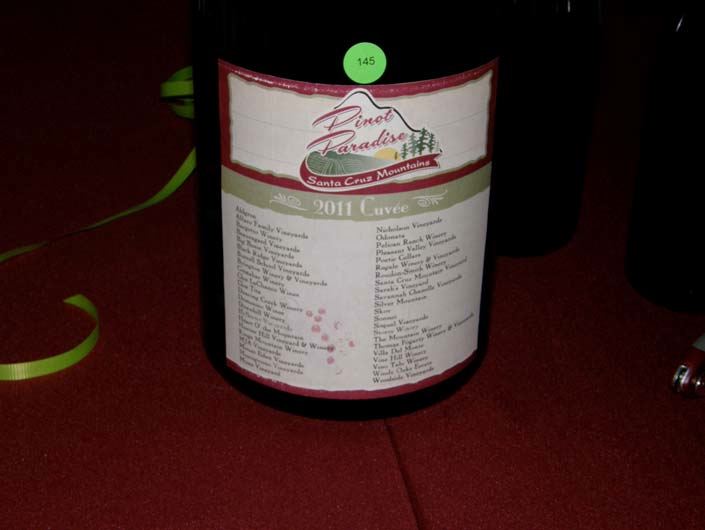 The Santa Cruz Mountains Winegrowers Association next event is the Spring Wine Passport, April 16, 2011. Passport occurs four times each year allowing wine enthusiasts to visit wineries not normally open to the public. Another event, the Santa Cruz Mountains Wine Express at Roaring Camp Railroad is May 15, 2011 which includes over 70 wineries, great food, music, and a train ride through the Santa Cruz Mountains (kids and dogs welcome). Visit www.scmwa.com for more information.
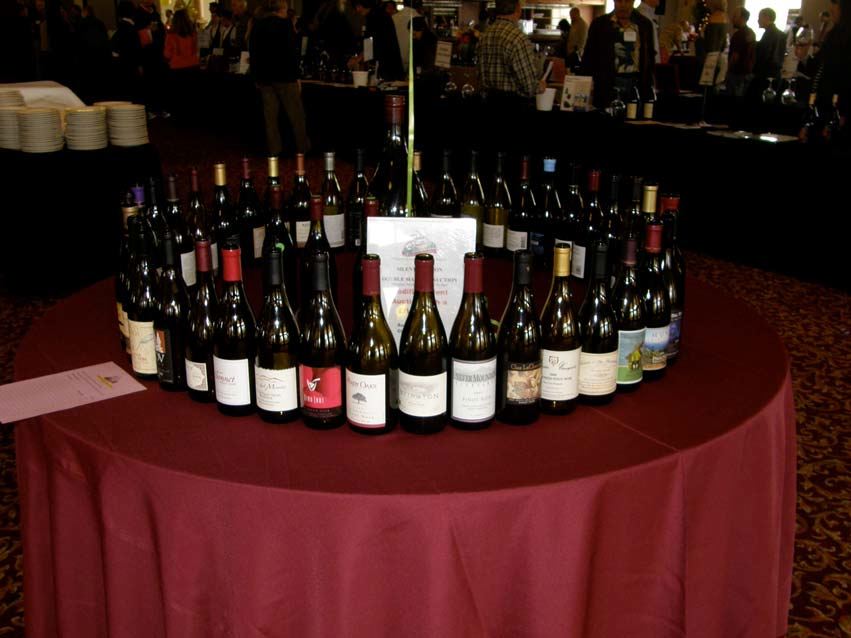
Pinot BriefsAnnual Dundee Hills Passport Tour The Dundee Hills Winegrowers Association is sponsoring this annual event to be held April 16 and 17, 2011. Tasting fees are 50% off with the purchase of a passport ($15) and vineyard seminars are included. Visit www.dundeehills.org for information. A companion to this event is the Dundee Hills World Tour Pass ($100) which allows one person free standard tastings at participating wineries and savings on lodging, restaurants and Dundee Hills Winegrowers Association events. Plenty of top notch wineries are included: Alexana Winery, Archery Summit, Argyle Winery, Daedalus Cellars, DePonte Cellars, Domaine Drouhin Oregon, Domaine Serene, Dusky Goose, Erath Winery, The Eyrie Vineyards, The Four Graces, Lange Estate Winery & Vineyards, Stolleer Vineyards, Torii Mor Vineyard & Winery, White Rose Wines and Winderlea Vineyard & Winery.
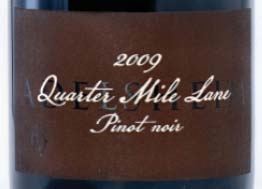 Adelsheim to Sport New Labels Adelsheim single vineyard Pinot Noirs to be released in the fall of 2011 and spring of 2012 will have new labels designed by Flint Design of Portland, the masterminds behind many of Oregon’s great wine labels. President David Adelsheim said, “We came to realize that our previous labels did a good job of explaining our past, but did not address our aspirations about the kind of company we intend to become in the future.” Adelsheim Vineyard estate, established in 1971, includes 11 vineyard sites in the Willamette Valley totaling 235 acres. The winery now produces 40,000 cases annually. The winery and vineyards carry the L.I.V.E. certification and many wines now carry the OCSW logo. In 2011, Adelsheim Vineyard is celebrating its 40th Anniversary. A number of special events are planned to commemorate the Anniversary including a gala on Sunday, August 13. Visit the website at www.adelsheim.com. West Sonoma Coast Vintners Festival A reminder about the inaugural West of West Wine Festival, to be held this year from August 5 through 7. The event will be in the coastal Hamlet of Occidental, California which has become the hotbed for California Pinot Noir. How does a tasting of older wines with Burt Williams and Ted Lemon sound? Member wineries include Cobb, Flowers, Freeman, Hirsch, Martinelli and Peay. For information visit www.westsonomacoast.com. I have rented a house in Occidental, bringing some friends, and have tickets for the entire event. Inman Family Wines Earth Day Celebration On Friday, April 21, and Saturday, April 22, 2011, Kathleen Inman is hosting tours of her vineyard and new winery, a tasting of current releases, a sit down vertical tasting of three vintages of OGV Estate on both days, and live music from Adam Lieb on Saturday. Learn about the winery’s organic farming practices and the program whereby they spread compost from San Francisco restaurant scraps and brew compost teas. To secure seating at the tasting, visit www.inmanfamilywines.com.
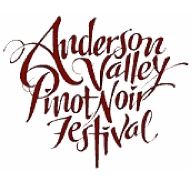 Anderson Valley Pinot Noir Festival The Anderson Valley Winegrowers Association (AVWA) will host the 14th Annual Pinot Noir Festival on May 20-22, 2011. The day-long Technical Conference and educational seminar will be held on Friday, May 20, with a focus on vine nutrition, yeasts, and whole cluster fermentations. An afternoon-only ticket for serious consumers will offer in-depth tastings and presentations from local and guest vintners. Wine author Karen MacNeil will be a featured afternoon speaker. The Technical Conference will be followed by a casual barbecue at Navarro Vineyards. The Grand Tasting will again be held at Goldeneye. Participating wineries include Balo Vineyards, Baxter Winery, Berridge Wine, Black Kite Cellars, Breggo Cellars, Brutocao Cellars, Claudia Springs Winery, Copain Wines, Couloir Wines, Drew Family Wines, Elke Vineyards, Esterlina Vineyards, Expression Wines, Foursight Wines, Fulcrum Wines, Goldeneye Winery, Greenwood Ridge Vineyards, Handley Cellars, Harmonique Wines, Harrington Wines, Husch Vineyards, Jim Ball Vineyards, Lazy Creek Vineyards, Londer Vineyards, LuLa Cellars, MacPhail Family Wines, Maple Creek Vineyards, Navarro Vineyards, Phillips Hill Estates, Philo Ridge Vineyards, Roederer Estate, Roessler Cellars, Saintsbury, Schraffenberger Cellars, Standish Wine Co., Toulouse Vineyards, Twomey Cellars, Waits-Mast, and Zina Hyde Cunningham. Winemaker dinners will be held in the Anderson Valley and on the Mendocino Coast on Saturday evening, May 21. The weekend concludes on Sunday, May 22, with open houses at Anderson Valley wineries. Tickets and information is available at www.avwines.com. Outstanding in the Field Tickets went on sale on March 20, 2011 for Outstanding in the Field dinners scheduled between May 1 and December 4, 2011. Events are generally less than one hour drive from metro areas. The mission is to reconnect diners to the land and the origins of their food and to honor local farmers and food artisans. Outstanding in the Field is a roving culinary event, literally a restaurant without walls. Ingredients for each meal are almost all local and generally prepared by celebrated chefs. Meals are shared with farmers, culinary artisans and winemakers. Visit www.outstandinginthefield.com for the 2011 schedule and to acquire tickers. The dinners are often sold out far in advance.
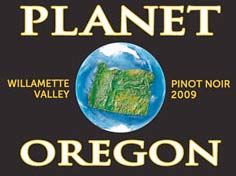 Planet Oregon This is renowned winemaker Tony Soter’s new wine project. Soter’s mission statement: “Our purpose is to produce persuasively good Oregon Pinot for people uninterested in pomp, pretense or posturing. A populist product that is pure and positively progressive. Only Oregon Pinot Noir. Passionately produced but practically packaged. The perennial taste of Planet Oregon at a palatable price.” Soter is working with the Oregon Certified Sustainable Wine (OCSW) program to bring attention to sustainable growing practices in Oregon. The first release of Planet Oregon Willamette Valley Pinot Noir is from the 2009 vintage. It is a fruit-forward, easy drinking wine with no pretensions. The wine is available at www.northwest-wine.com for $19.95. A dollar from the sale of each bottle supports the work of the Oregon Environmental Council. The Chardonnay Symposium SMVWINES presents The Chardonnay Symposium, the only event of its kind in the United States focusing on Chardonnay. Friday, July 22, leads off with a tour of Sierra Madre Vineyard and in-depth presentation of its eight different clones of Chardonnay. That evening, Sierra Madre Vineyards celebrates its 40th Anniversary with a Gourmet Barbecue prepared by Chef Rick paired with Sierra Madre’s Chardonnays. Saturday, July 23, begins with two educational panels at Bien Nacido Vineyard and Tantara Winery featuring Karen MacNeil, author of The Wine Bible, and Steve Heimoff, wine critic for Wine Enthusiast, together with a winemaker panel exploring “The State of the Golden Grape.” All-day guests are invited to a luncheon at Au Bon Climat Winery. The afternoon Grand Chardonnay Tasting features 50 wineries from Washington, Oregon, Sonoma and the Central Coast at Byron Vineyard and Winery. For more information, including a detailed event schedule, visit www.thechardonnaysymposium.com. Monterey Wine Country’s Annual Summer Festival The Monterey County Vintners & Growers Association (MCVGA) is sponsoring the 19th Annual Winemakers’ Celebration on August 13, 2011, at The Barnyard Shopping Village in Carmel. MCVGA represents over 80 vintners and growers in Monterey, California. Nine AVAs make up Monterey County including Monterey, Santa Lucia Highlands, Arroyo Seco, San Lucas, Hames Valley, Chalone, Carmel Valley, San Antonio Valley and San Bernabe, comprising 200 vineyards. Forty-two varietals are produced from this single winegrowing region. The event will feature wineries, culinary treats, jazz music, winemaking displays, and a Silent Auction. For additional information, visit www.montereywines.org. NW Wine Company to Relocate in Dundee NW Wine Company, was founded in 2003 by a partnership consisting of John Niemeyer and Jeff Meader of Oregon Wine Services, Laurent Montalieu and Danielle Andrus Montalieu. The winery has grown from 19,000 cases to as much as 120,000 cases during the past eight years. The move will allow NW Wine Company to expand and have both a highly specialized 45,00 square foot winery, an estate vineyard and an on site tasting room. The new location is on 35 acres in the southern end of Dundee at the junction of Highway 99W and Niederberger Road. The NW Wine Company partners also own Hyland Estates, one of the oldest vineyard sites in the McMinnville AVA. Purchased in 2007, Hyland consists of over 260 acres with plantings originating in 1971. NW Wine Company will premier their label, Hyland Estates, to coincide with the opening of their new tasting room. The Montalieus now lease and manage vineyards in all six of the Willamette Valley AVAs. A breaking ground ceremony will be held Friday, April 8, at 11:00 AM. San Franciso BayList 2011 Winery Popularity Winners: McGrail Vineyards and Winery (Livermore), Scharffenberger Cellars (Mendocino), Frank Family Vineyards (Napa), Stage Left Cellars (San Francisco) and Alexander Valley Vineyards (Sonoma). Vineyard & Winery Management Magazine 2011 Grand Harvest Awards Celebrating its 21st year, the Grand Harvest Awards competition is unique in that the entries are presented to the judges according to regional classification. This year’s results are posted at www.vwm-online.com/gha. A total of 1,346 entries, primarily from the United States and a total of 145 Gold Medals were warded. The tasting judges are a distinguished group of professions in the wine and food industry. The Pinot Noir Gold Medals: Anderson Valley - 2007 Handley Cellars ($30), Arroyo Seco - 2009 Ventana Ventana Vineyards ($29) and 2008 Scott Family Estate ($39), Mendocino - 2008 Handley Cellars ($25), Russian River Valley - 2009 Graton Ridge Cellars Estate ($50), Santa Cruz Mountains - 2007 Kings Mountain Vineyards ($39), Sonoma Coast - 2008 Nicholson Ranch Wines ($35), and Sta. Rita Hills - 2008 Alma Rosa Winery & Vineyards ($32). Barrique Owner Jim Howell has operated a unique wine bar in Jackson Square in San Francisco for over a year that features 18 California wines available straight out of barrel along with a substantial bottled wine list. Prices of the barreled wines are lower than by-the-glass wines (typically $7-$14 a glass from barrel). The barrels are labeled by grape variety and origin, and not producer to remove any preconceived notions associated with labels. The wines are often sourced from very small producers. Will we eventually be able to have our own barrel of wine at home? Visit www.facebook.com/BarriqueSF. Wine Faults. Feel intimidated when others claim a wine is corked or horsey and the wine smells perfectly fine to you? When you open a wine and it tastes “weird,” you have no idea why? Eliminate your insecurity and educate your mind and palate. Buy a copy of Wine Faults Causes, Effects, Cures written by John Hudelson. Both microbial and process-caused wine faults are reviewed in detail in a writing style that the average consumer can understand. Available from The Wine Appreciation Guild at www.wineappreciation.com. To learn to identify wine fault aromas, acquire the Le Nez Du Vin Faults Kit which contains small vials of liquids that emit aromas of the common wine faults such as cork taint, oxidation, and over-sulphiting. Available at www.WineAromas.com. Map of California’s AVAs The Wine Institute has created a map of California’s diverse winegrowing regions and includes a listing of all AVAs. The map is part of the Wine Institute’s Discovery California Wines promotion. It is free and can be downloaded from www.discovercaliforniawine.com/learn/map. Bill Hambrecht Opens VML Winery Wealthy investment banker Bill Hambrecht has split from C. Donatiello who is relocating, and Hambrecht has joined with winemaker and viticulturist Virginia Marie Lambrix ("VML"), Phil Hurst, Paul Dolan and son Heath Dolan, owners of Truett Hurst Winery in Healdsburg, to launch VML Winery. The new winery will open in existing facilities previously occupied by C. Donatiello Winery on Westside Road. The new winery will focus on wines in a price range ($14 to $30) directed at the millennial generation. Plans are to produce 100,000 cases by 2012. Santa Maria Valley AVA Expanded 19,000 acres have been added to the Santa Maria Valley AVA. The new areas are primarily south of the original AVA that have been planted with vines since the AVA was approved in 1981 and include Solomon Hills Vineyard. Wine & Spirits Magazine Restaurant Wine Popularity The magazine’s annual poll reportedly found, “Pinot’s surge in popularity may have reached a plateau.” Similarly weighted wines from other regions such as the Loire Valley have picked up interest and may be cutting into Pinot Noir’s popularity at restaurants in the United States. The most popular Pinot Noirs in restaurants: 1. Merry Edwards, 2. La Crema, 3. Emeritus, 4. Laetitia, 5. Au Bon Climat, 6. Belle Glos, 7. Argyle, 8. Elk Cover, 9. Domaine Drouhin, and 10. Littorai. Santa Barbara County Vintner’s Festival The Santa Barbara County Vintner’s Association is holding its annual Vintner’s Festival at River Park in Lompoc on Saturday, April 16, 2011, from 1-4 PM. Wines from over 110 members of the Association will be offered along with wine country foods, live music, and a silent auction. Wineries will be hosting events throughout the region starting on Friday, April 15. For information and tickets, visit www.sbcountywines.com.
Vertical The Novel: Vertical But Still Sideways
 Miles has found fame and financial success, fueled by his novel, Shameless, which has been made into a wildly popular movie. He has become a chick magnet and a full-fledged idol, empowered with a full-time publicist, and flush with a full cellar of Pinot Noir to fuel his passion. Despite his apparent nirvana, he remains a depressed, tormented, insecure and tragic figure who has fallen into the depths of alcoholism. He is searching for a female soulmate to rescue him from his mental instability. Jack is divorced, still oversexed, out of work, and drinks even more than Miles, if that is possible. He remains Miles’ closest friend, and when Miles hatches an idea to drive his stroke-ridden and wheelchair-bound mother to Sheboygan, Wisconsin to live with her sister, Jack signs on as shotgun and drinking buddy. Miles has been invited to be the Master of Ceremonies at the International Pinot Noir Celebration (IPNC), and a short stop in Oregon is planned. As you might imagine, many unforeseen comedies play out and considerable debauchery ensues on the trip. Jack’s unfortunate bout of priapism (he takes Viagra to counteract the effects of alcohol, a combination that would make any physician cringe) is the funniest interlude in the book. In a handicap-fitted van, along with a Filipino pot-smoking aid to care for Miles’ mother, the foursome head north, stopping briefly at the scene of their tragicomedy portrayed in Shameless (aka Sideways) at the Hitching Post restaurant and Foxen tasting room. Further along on the trip, Miles reenacts his infamous feat of drinking out of a spit bucket during a talk at the World of Pinot Noir (WOPN). It’s then off to McMinnville, Oregon, for the IPNC with miles pronouncing, “Willamette’s the next Burgundy.” Miles professes a preference for Willamette Valley Pinot Noirs over Central Coast Pinot Noirs he fancied in Sideways, criticizing the Central Coast versions as ramped up with Syrah and overproduced by greedy commercialization. Many Oregon blue-blooded Pinot Noirs are consumed along the trip including wines from Anne Amie, Bergstrom, Elk Cove, Raptor Ridge, Soter, and St. Innocent. Ironically, the wine that takes center stage in Oregon is not an Oregon Pinot Noir, but a Burgundy: a jeroboam of 1996 Gevrey- Chambertain Clos de Beze drunk on the night of the IPNC Salmon Bake. After taking a slug, Miles notes, “In the mouth, it caressed my palate like a candied ectoplasm that clung preternaturally until the last bit disappeared.” Merlot bashing seems like a tired joke, but is revived in this sequel. At the welcoming ceremonies for IPNC, Miles is talking about his “favorite mistress” - Pinot Noir, and in closing, says, “In Santa Ynez they’re such a bunch of money making whores, they’d probably go back to planting F*#&ING MERLOT.” At the Salmon Bake, Miles is dunked in a vat of Merlot as a charity stunt, a clever bit by the author. When Miles leaves Oregon for Wisconsin, the book turns maudlin, with Jack leaving the group for a job offer in Los Angeles, and Joy, the Filipino caretaker, deserting Miles. Frustrated, but undaunted, Miles troops on with his disabled mother. Considerable introspection ensues, the pairs’ previously desultory relationship warms up, and the story ends on an inevitable sad note. Miles throws out polysyllables with unabashed frequency throughout the book, and one will need a thick dictionary to decipher the meanings of words like deliquescence, quotidian, inchoate, solipsistic, prestidigitation, and alacritous. Despite this, his prodigious vocabulary adds to his character. Entertaining as it is, this book will bring less notoriety to Oregon’s Willamette Valley than Sideways did for Santa Barbara County. Miles and Jack only spend a couple days in Oregon and visit no wineries. The IPNC is portrayed as a bacchanal, described by Miles as having, “All the Dionysian makings of a royal descent into Hades.” I am sure the organizers of this cherished event will wince about this exaggerated depiction of the tone of the Celebration. Concluding the Opening Ceremonies speech at IPNC, Miles coaxes the assembled, “Let’s all go get F*#&ED UP ON PINOT!” The book may bring more notoriety to Pfizer Pharmaceuticals (the maker of Viagra and Xanax), than to Pinot Noir. Sequels are always fraught with risks, and although Vertical has many entertaining moments, it relies heavily on sexual histrionics to deliver its message. The excessive drinking depicted in Sideways turned off some people, and the same readers will find a continuance in this escapade. Putting all this nitpicking aside, if you loved Sideways, you will thoroughly enjoy Vertical. |